Your cart is currently empty!
Tag: TMUA
-
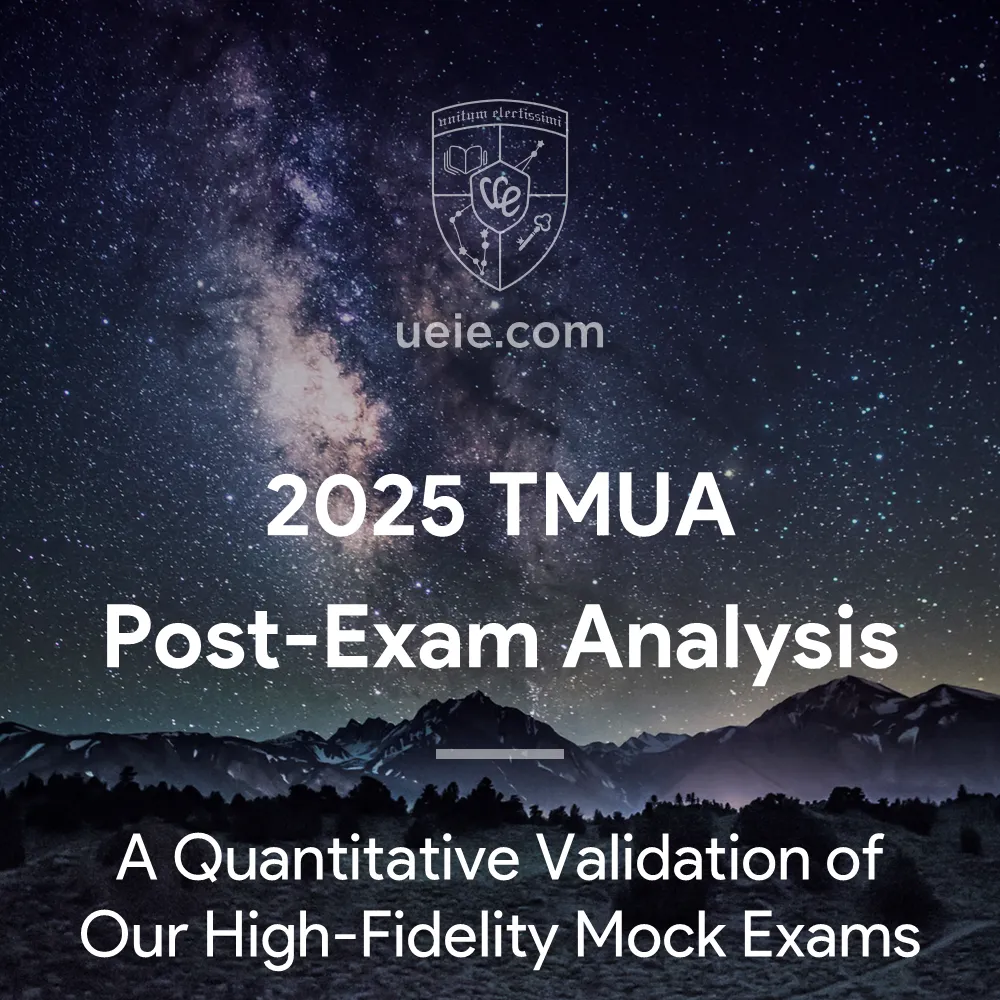
2025 TMUA Post-Exam Analysis: A Quantitative Validation of Our High-Fidelity Mock Exams
The 2025 TMUA is all done and dusted. While all the talk was about ‘multiple papers’ and candidates were getting anxious about whether the difficulty was even fair, we were chuffed to find that the feedback from UEIE students was just… calm and confident.
And that calm wasn’t a fluke. It was the inevitable result we’d already predicted and proven. The bottom line is: even though the papers were all different, their core difficulty was precisely locked into a very specific range.
That is all down to the smart design of our prep system. In this article, I’m going to properly deconstruct that system and reveal the logic behind how our students stay so composed.
I. A Prep System Designed to Work: How to Handle the Real TMUA Challenge
The reason the UEIE prep system is so effective is that it’s not just theory. It’s a smart system, properly designed from the ground up to handle the messy, complex challenges of the real exam. The whole thing is built around our eight mock papers, which are split into three difficulty modes: ‘Simulation’, ‘Challenge’, and ‘Confidence’. Right, I’m going to break down the logic behind this, using what we saw in this year’s real TMUA exams.
1. The ‘Simulation’ Mode: Replicating the Battlefield to Beat the Clock
As always, the TMUA demands you be incredibly slick with your calculations, and the time pressure is relentless, from start to finish. The entire point of the ‘Simulation Mode‘ is to train students to make quick, accurate calculations and decisions under that exact pressure. By running these high-intensity mocks under strict exam conditions, our students just get used to the pace. That exam-hall ‘stress’ becomes their everyday ‘normal’. It means that when the time comes, they can comfortably bank all the marks from the standard questions without running out of time.
2. The ‘Challenge’ Mode: Pushing Your Limits to Tackle Those Weird, New Questions
Just like in previous years, there are always a few curveball questions designed to sort the top students from the rest. That’s exactly what our ‘Challenge Mode‘ is for. The goal is to smash through a student’s ‘thinking ceiling’. By training them with much harder, higher-level thinking, we give them the mental flexibility they need. When a student who’s been through the ‘Challenge Mode’ wringer sees a weird-looking question , they’re just much faster at seeing the underlying maths and finding a way in.
3. The ‘Confidence’ Mode: Building a Rock-Solid Foundation to Beat the ‘Trap Questions’
One of the main things about this year’s exam was the sheer number of ‘trap’ questions. We’re talking nasty little traps hidden in the most basic definitions, logic, or boundary conditions—dead easy to fall for and hard to spot. This is exactly why our ‘Confidence Mode‘ is so essential. The aim here is to do a ‘carpet-bomb’ review of every single core topic, making sure those fundamentals are absolutely rock-solid. That way, our students can spot and dodge these simple-looking traps on autopilot, protecting all their hard-earned basic marks.
II. From Theory to Practice: How the Data Proves Our ‘Two-Round, Three-Mode’ System Works
Whether a prep system is actually any good all comes down to the data. Our system—what we call ‘Two Rounds, Three Modes, Four Stages, Eight Mocks’ – is built around this idea. It’s two rounds of the three difficulty modes, run in an alternating four-stage pattern of ‘Simulation-Challenge-Simulation-Confidence. We’ve got the hard, quantitative proof from our back-end data that this cyclical training flat-out works.
1. The ‘Macro’ Evolution: The Rhythm Behind the ‘Growth Ladder’
Our TMUA Score Distribution Graph (see below) perfectly captures how the whole group of student ‘evolved’ through these repeating ‘stress-and-recover’ cycles. Let’s break down the rhythm behind these curves.
Round 1: ‘Pressure and Recovery’ (Mocks 1-4)
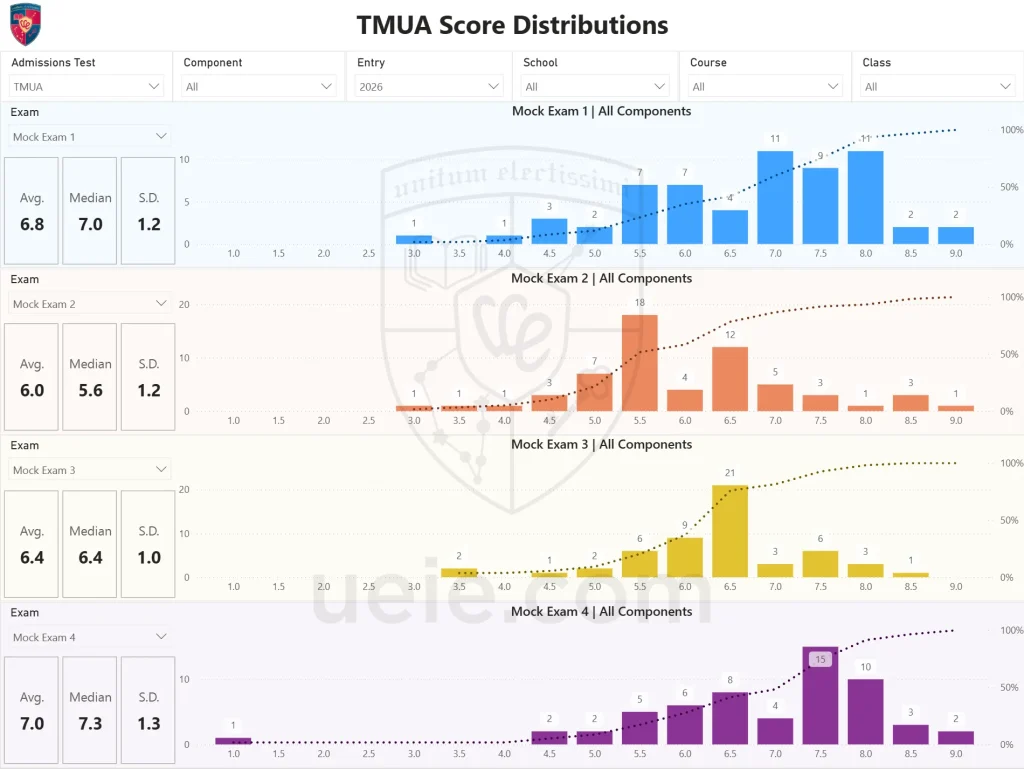
UEIE Mocks 1-4: TMUA Score Distribution & Averages
(Exam Period: Sept-Oct 2025)First, the students set their baseline in Mock 1 (‘Simulation’). Then, we immediately hit them with a high-intensity stress test in Mock 2 (‘Challenge’), and you can see the scores clearly shift to the left (the average dropped from 6.8 to 6.0). This ‘planned dip’ was designed to expose all their weak spots. After that, Mock 3 (‘Simulation’) let them apply what they’d learned in a realistic test, and Mock 4 (‘Confidence’) pulled the difficulty back a bit. This let them consolidate their knowledge, rebuild their confidence, and you see the scores shoot right back up (average climbing to 7.0).
Round 2: ‘Forging and Peaking’ (Mocks 5-8)
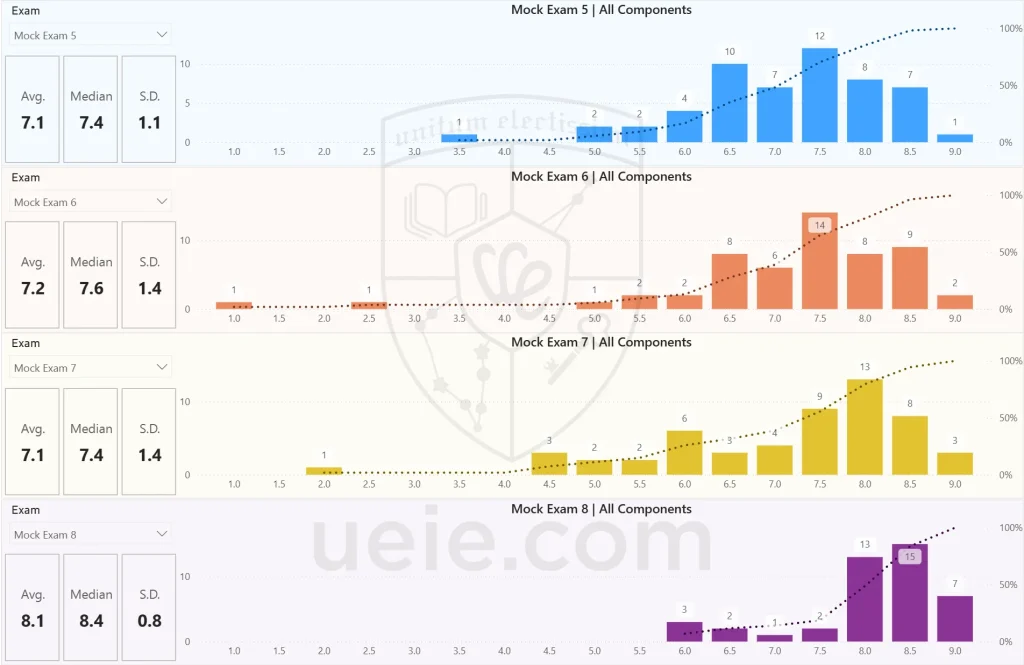
UEIE Mocks 5-8: TMUA Score Distribution & Averages
(Exam Period: Oct 2025)Then, we simply repeated the cycle. But look closely: in Mock 6 (the second ‘Challenge’ test), the group’s scores didn’t nosedive this time. This is the single best bit of proof that the training was working: their knowledge base and their ability to handle pressure had been systematically toughened up, so they could take on the hard stuff without buckling. Finally, by Mock 8 (‘Confidence’), the entire group surged to a peak average of 8.1 and a median of 8.4, and they were all tightly clustered together with a standard deviation of just 0.8.
2. The ‘Micro’ Journeys: Two Classic Paths to the Top
Of course, this clever training rhythm needs to be paired with spot-on diagnostics. Our Student Personal Report system plots a totally unique growth curve for every single student. Here are the two most typical success stories.
The Textbook Case of ‘Excellence and Stability’
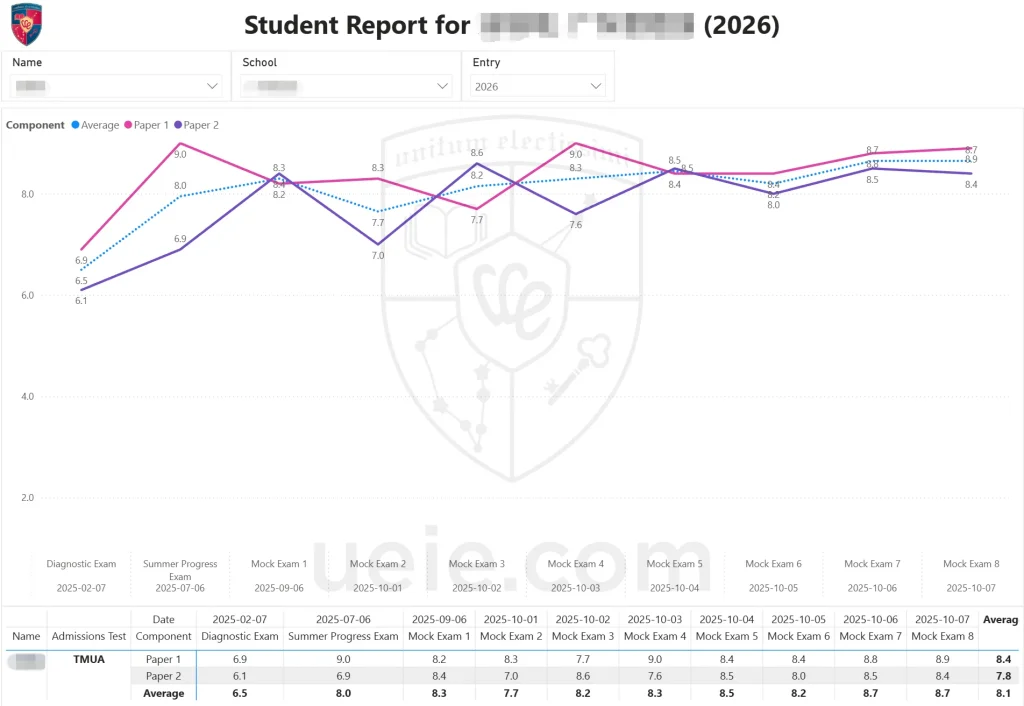
Typical Student (A) – Mock History
(Studying from Feb-Oct 2025)Look at this student’s curve. It barely flinched, even during the two ‘Challenge’ mocks (2 and 6). It just shows how incredibly resilient they are. This proves our system helps top-tier students stay on top, handle the pressure, and turn excellence into a stable, repeatable habit.
The Definition of ‘Resilience and Breakthrough’
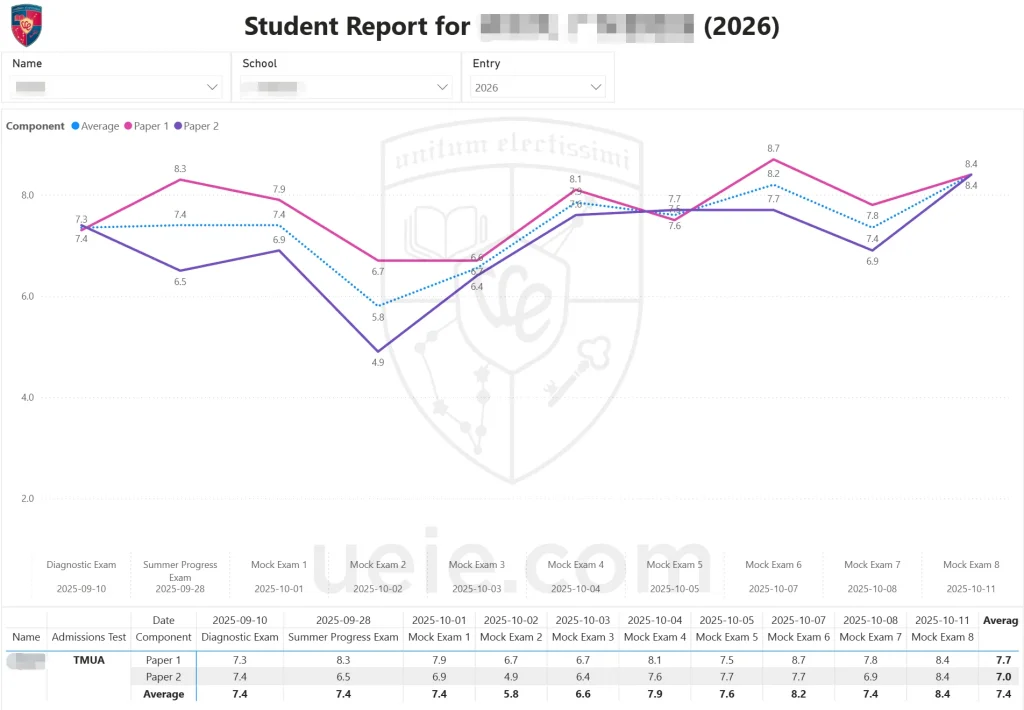
Typical Student (B) – Mock History
(Studying from Sept-Oct 2025)This student did a full sprint-prep in less than two months, and their graph is the perfect ‘pressure-and-recovery’ story. This is what efficient prep and a personal breakthrough look like. They took a massive hit in Mock 2, but that became the catalyst. They used it to push on, climbed steadily through the rest of the mocks, and hit a new personal best in Mock 8. It’s just undeniable proof that our system can effectively guide students to learn from their ‘failures’ and come out stronger on the other side.
III. What’s Next: Turning Your TMUA Edge into an Interview Win
Look, a top-notch TMUA score is a massive piece of academic proof when you’re applying for courses like Computer Science, Maths, or Economics at places like Cambridge, Imperial, and Warwick. But let’s be honest: all it does is get your foot in the first door.
The real decider is the interview. And it’s testing a completely different set of skills from the written exam. This is where you go from ‘theory on paper’ to a ‘face-to-face showdown’. The interviewers aren’t just looking for a student who can churn out the right answer anymore. They want to see a future academic—someone who can clearly explain how they’re thinking, even when they’re under pressure, and who shows genuine academic curiosity and a logical mind.
So, we’ve taken the exact same hardcore, systematic approach we used to deconstruct the TMUA exam, and we’ve applied it to deconstructing the interview. That’s why the UEIE Oxbridge Interview Coaching programme is now officially live. Our goal is dead simple: to take all the knowledge and confidence you built up for the exam and turn it into a decisive, winning performance in that interview room. We’re here to get you over that ‘final mile’.
Our entire course is built around three core modules:
1. 1-to-1 High-Fidelity Mock Interviews
These are led by tutors with serious, senior-level interview experience from Oxbridge and Imperial. We perfectly replicate the pressure and academic depth of the real thing, giving you proper, hands-on combat practice.
2. Logical Framework & Verbal Expression Training
We don’t feed you ‘standard answers’. We train you how to build and communicate your thought process, clearly, even when you’re under the cosh. This is the toolkit that will let you handle any curveball question they throw at you with total confidence.
3. Pushing Your Horizons to the Academic Frontier
We’ll get you discussing cutting-edge topics that go way beyond the A-Level syllabus. This is all about helping you build your own unique academic perspective, so you can walk in there and show them you’ve got real passion and huge potential for the subject.
Act Now
To make sure the coaching quality is absolutely top-tier, our interview places are strictly limited, and they are only available to students who have already bought UEIE courses or study materials. If history is anything to go by, these spots will be snapped up incredibly fast.
-

ESAT & TMUA Sprint Playbook
In early September 2025, with just one month remaining until key admissions exams like the ESAT and TMUA, we conducted our third stage of benchmark exams. This serves not only as an assessment of past efforts but also as our most valuable strategic roadmap for the final push.
This report provides an in-depth analysis of the exam data, helping you to clearly see your progress, pinpoint areas for improvement, and formulate the most effective preparation strategy for the final thirty days. Remember, every moment of reflection now is an investment in a successful outcome.
I. About the Exams
1. Exam Details
Program Stage 1:
Diagnostic ExamStage 2:
Summer Progress ExamStage 3:
Benchmark ExamExam Type ESAT & TMUA Question Source Original Mock Exams Exam Format Time-limited Online Exam Exam Difficulty ★★★★ ★★★☆ ★★★★ Exam Dates Feb-Jun, 2025 Jul-Aug, 2025 Early Sep, 2025 Exam Scope Open to the public globally*
Internal Exam
Internal Exam
No. of Participants 150+ 50-60 60-70 * The exam was open to participants of all nationalities and ages, with the majority coming from over 30 countries and regions, including mainland China, the UK, India, and Hong Kong.
** The difficulty level was benchmarked against the October 2024 ESAT and TMUA examinations: ★★★
2. Exam Papers and Score Conversion
To ensure fairness and validity, all exams used highly realistic, custom-written questions, with no past paper content. The time limits were identical to the actual exams, and the computer-based exam interface replicates the official platform with over 99% accuracy.
Links to all exam papers and their score conversion tables can be found below. Please note that access to most papers, excluding the diagnostic exam, requires authorisation.
Exam Stage Exam Papers (and Links) Score Conversion Table Conversion Table Version Used Diagnostic Exam TMUA Diagnostic Exam Paper 1
Paper 22025.06.30 ESAT Diagnostic Exam Maths 1
Maths 2
Physics
Chemistry
BiologySummer Progress Exam TMUA Summer Progress Exam Paper 1
Paper 22025.08.30 ESAT Summer Progress Exam Maths 1
Maths 2
Physics
Chemistry
BiologyBenchmark Exam TMUA Mock Exam 1 Paper 1
Paper 22025.09.08 ESAT Mock Exam 1
3. Explanation of the Score Conversion Table
To ensure that a student’s score accurately reflects their relative standing among global candidates, UEIE academic team applies its deep professional experience and a unique algorithmic model to conduct a curve-fitting analysis of the exam data. This process generates a unique score conversion curve for each exam paper, from which the corresponding score conversion table is derived.
Please note that as we continuously acquire new performance data, the conversion curve for each exam is dynamically optimised. Consequently, minor differences may be observed in tables viewed at different times.
Furthermore, although the difficulty level varies between exams, our conversion model has minimised the impact of this variable on the final score to a negligible level.
4. A Brief Guide to the Reported Score
The percentage score is converted into a Reported Score on a scale of 1.0 to 9.0, with 9.0 being the maximum mark.
The number of correct answers needed for a certain score varies by paper and is detailed in each conversion table.
The table below shows the general correlation between Reported Scores and global candidate rankings.
Reported Score Approximate Global Ranking 8.5 Top 3% 8.0 Top 5% 7.5 Top 10% 7.0 Top 15% 6.5 Top 20% 6.0 Top 25% 5.0 Top 50% (The data in the table represents the personal opinion of Xie Tao.)
II. Performance Data and Statistics
To simplify this analysis, the Reported Scores for students across the ESAT and TMUA exams have been combined.
- For TMUA, the average of the two papers is used.
- For ESAT, the average of the three sections is used.
- The average Reported Scores of all students from each exam onstitute the raw data.
1. Performance Trend Over Time
Metric Diagnostic Exam Summer Progress Exam Benchmark Exam Mean Score 5.37 6.37 6.78 Median 5.4 6.4 6.9 Standard Deviation 1.51 0.97 0.89 2. Performance Histograms from Each Exam Stage

Diagnostic Exam Scores
(February – June 2025)
Summer Exam Scores
(July – August 2025)
Benchmark Exam Scores
(Early September 2025)III. Our Progress: Growth Demonstrated by Data
Comparing the data across the three exam stages reveals encouraging signs of progress:
- Significant improvement in overall performance: Both the mean and median scores show a steady upward trend, with the mean score rising from 5.37 to 6.78. This proves the effectiveness of the systematic revision and training from the first two stages.
- The performance gap is narrowing: A steady decrease in the standard deviation (from 1.51 to 0.89) shows that the gap between students is closing. Higher-performing students are consolidating their strengths, while others are working hard to catch up, creating a positive and competitive atmosphere.
IV. Priorities for the Home Straight: Eight Key Areas to Conquer
While this improvement is commendable, we must address the common challenges revealed in this exam. Think of these not as “problems,” but as your clearest opportunities to boost your score.
- Knowledge Retention: Forgetting recently learned topics, particularly in TMUA Paper 2 and the ESAT science sections.
- Conceptual Ambiguity: Imprecise understanding of fundamental concepts and definitions, leading to lost marks on “trick” questions.
- Calculator Dependency: Reduced speed and proficiency in manual calculation due to long-term reliance on calculators.
- Reading Speed Bottlenecks: Slow processing of technical English and long questions, which impacts problem-solving efficiency.
- Sub-optimal Strategies: Using conventional methods to solve problems when faster, more elegant techniques would save valuable time.
- Reduced Practice Time: Summer activities and personal statements have squeezed practice time, leaving students feeling out of touch.
- Stamina and Endurance: A noticeable decline in concentration and energy during longer exams (over 1.5 hours).
- Mindset and Focus Under Pressure: Performance being affected by technical issues, simple errors, or seeing an interim score update.
V. To Our Students: Execute Your Final Push Plan
To address these key areas, execute the following strategies with focus and precision over the final month:
Consolidate Knowledge (For points 1 & 2)
Action: Don’t just review your mistakes—dissect them. Group errors by topic for deeper reflection. Write out key definitions and formulae and place them where you’ll see them every day.
Practise Deliberately (For points 3 & 4)
Action: Take the “Calculator Detox” challenge. From now on, do all calculations with pen and paper. For reading, set a timer and practise reading technical texts or long-form questions every day to improve your speed.
Optimise Your Technique (For points 5 & 6)
Action: Time is your most valuable asset. Commit to a fixed practice schedule. When practising, don’t just aim for the right answer—strive for the “optimal solution.” Master the smart techniques taught in class.
Simulate Exam Conditions (For points 7 & 8)
Action: Physical and mental stamina are critical. Use the 7 upcoming mock exams as your training ground. Adhere strictly to official timings and conditions. Remember: the purpose of a mock is to expose weaknesses. Every setback now is designed to ensure a smooth performance on exam day.
VI. To Our Parents: Providing the Strongest Support
In this final sprint, your support is your child’s greatest asset. We sincerely recommend that you:
- Focus on reassurance, not scores: Mock scores are part of the process. Help your child focus on the “why” behind their results and the “how” of their improvement plan. Your trust is the cornerstone of their confidence.
- Manage the logistics: A consistent routine, nutritious meals, and a quiet study environment are the foundation of effective preparation.
- Provide emotional support: Pay attention to your child’s emotional state. When they feel anxious, listen more and lecture less. A walk or a relaxed chat can be more effective than any motivational speech.
- Work in partnership with us: Trust the school, the teachers, and your child. Maintain communication with us so that, together, we can help them succeed.
VII. Conclusion: Trust the Process, Embrace the Challenge
This final month is for consolidating knowledge, refining skills, and, crucially, mastering your mindset. We hope this analysis helps clarify the path ahead. Please trust that every ounce of effort you have put in has forged the strength you possess today.
-
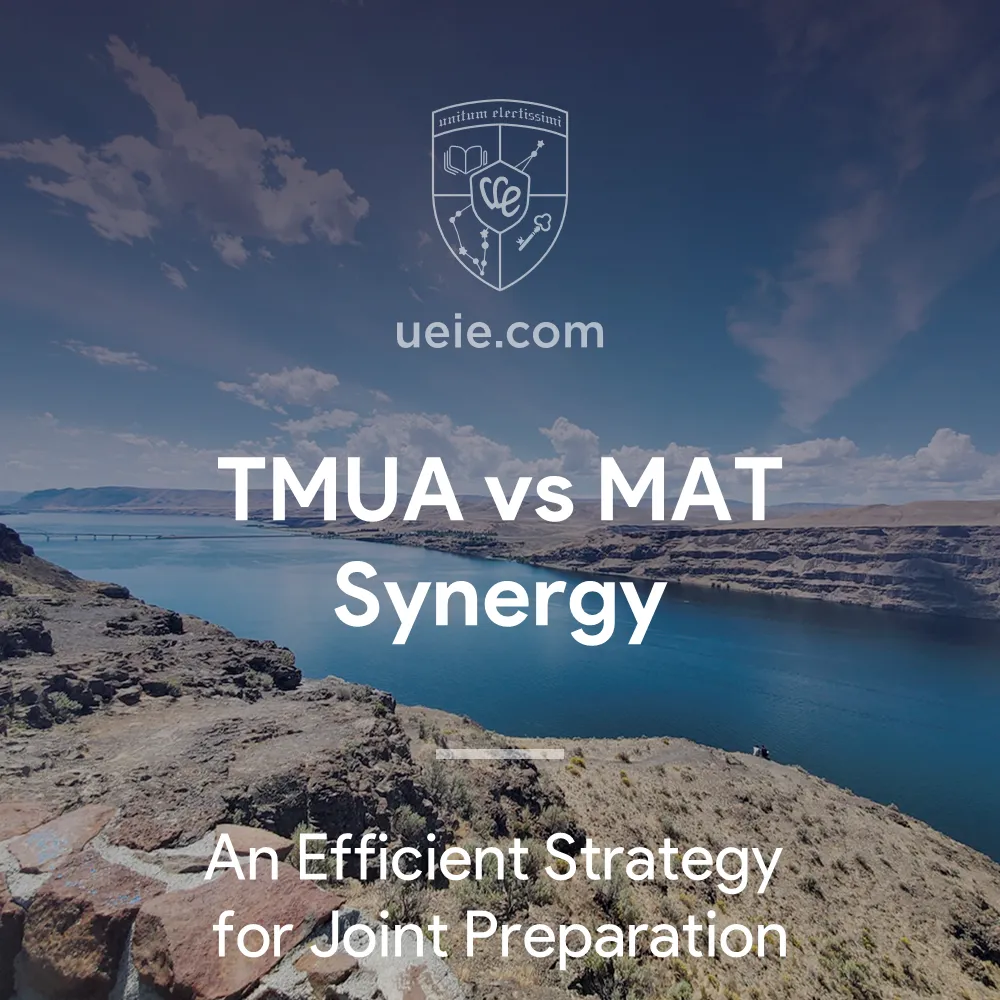
TMUA vs MAT Synergy: An Efficient Strategy for Joint Preparation
I. TMUA vs Oxford MAT: Why Are They So Often Mentioned Together?
Prospective students and parents targeting mathematics, computer science, economics, or other sought-after degree programmes at Oxbridge or other G5 universities will likely be familiar with the TMUA and the Oxford MAT (hereafter MAT) – two key mathematics admissions tests. Astute parents and students may have already spotted a crucial distinction: TMUA vs MAT — one examination (TMUA) is composed entirely of multiple-choice questions, while the other (MAT) features both multiple-choice and extended-response questions. These are fundamentally different examinations, so why are they often mentioned in the same breath, or even recommended for concurrent preparation? Could this approach dilute one’s focus?
This is an exceedingly common and pertinent query. This article aims to demystify the situation by directly comparing the TMUA and MAT, thereby revealing their ‘intrinsic connection’. I will explain why, for many students, preparing for these two examinations in tandem is, in fact, a more astute and efficient strategy – one capable of producing a synergistic effect greater than the sum of its parts (a ‘1+1>2’ outcome) – and will outline a clear and practical path to achieve this.
II. TMUA vs MAT: A Table for Understanding Core Similarities and Differences
First, let us consolidate the key information for the TMUA and MAT into a table, enabling you to discern their most crucial similarities and differences at a glance:
Dimension TMUA Oxford MAT Managing Body UAT-UK University of Oxford Exam Delivery Partner Pearson VUE Pearson VUE Response Format Online, computer-based Online, computer-based Question Types & Quantity 40 multiple-choice questions 25 multiple-choice questions + 2 extended-response questions Examination Duration 2.5 hours 2.5 hours Knowledge Base Primarily based on A Level Mathematics + some GCSE Mathematics Primarily based on A Level Mathematics Further Mathematics Not required Not required Examination Style Emphasis on speed and precision Emphasis on thinking and logic Assessed Abilities Rapid and accurate application of knowledge; logical reasoning agility. Rigorous logical thinking; creative problem-solving. Permitted Aids Calculators, formula sheets, and dictionaries are all prohibited. Calculators, formula sheets, and dictionaries are all prohibited. Scoring Method Standardised score: 1.0-9.0 (converted from raw score) Raw score: 0-100 Typical Universities / Majors - Cambridge (Computer Science, Economics) and compulsory for some Imperial/LSE/UCL programmes.
- Accepted or alternative for some Warwick/Durham programmes.
- Compulsory for Oxford Mathematics/Computer Science related programmes.
Keywords Speed, accuracy, logical reasoning, broad application Logic, problem-solving, mental flexibility, Oxford Brief Summary
Upon reviewing the table, you will observe that the TMUA and MAT do indeed exhibit distinct differences in question format (one being purely multiple-choice, the other a hybrid) and style (one prioritising speed, the other depth). However, their commonalities are also remarkably prominent: both are computer-based examinations, neither necessitates Further Mathematics, both are founded upon A Level core mathematics knowledge, and both place considerable emphasis on logical aptitude. These shared characteristics precisely form the basis upon which we can implement an effective joint preparation strategy.
III. ‘Combination’ and ‘Separation’: The Rationale and Key Aspects of TMUA MAT Joint Preparation
Having understood the core similarities and differences, you can now appreciate why the TMUA and MAT are suitable for ‘combined’ preparation, and yet necessitate ‘separate’ training in certain aspects.
1. Why ‘Combine’? – Unveiling the Intrinsic Connection
The feasibility and efficacy of joint preparation primarily stem from their close ‘intrinsic connection’.
A Highly Overlapping Knowledge System is Core
This is the most crucial point! Both the TMUA and MAT predominantly assess A Level Mathematics knowledge (mainly Pure Mathematics with a small amount of Statistics). Both are built upon core secondary school mathematics knowledge and neither requires the additional burden of studying Further Mathematics. This implies that when revising fundamental modules such as functions, algebra, calculus, and coordinate geometry, a single study pass can satisfy the majority of the knowledge requirements for both examinations, thereby avoiding substantial duplication of effort. This is the most significant efficiency gain!
Underlying Skills are Transferable
Whether it is the TMUA’s demand for rapid and accurate logical judgement or the MAT’s requirement for rigorous and in-depth logical analysis, a sound foundation in logical thinking is essential. Similarly, solid fundamental calculation skills, the ability to accurately express oneself using mathematical language, and basic problem deconstruction capabilities are vital for both examinations. Training these underlying skills can yield a ‘dual benefit from a single effort’.
Consistent Examination Environment
Both are computer-based examinations conducted at Pearson VUE test centres. Familiarity with the computer-based testing environment, on-screen reading, and online answering procedures is entirely transferable, reducing adaptation costs.
In simple terms, if we liken examination preparation to constructing a house, the foundational materials and load-bearing columns (core knowledge, underlying skills, examination environment) for the TMUA and Oxford MAT are largely identical. Tutors can construct them simultaneously, saving both time and effort.
2. Why ‘Separate’? – Unique Skills Require Dedicated Practice
Naturally, identical foundations do not equate to identical houses. The TMUA and MAT have different emphases regarding skill requirements; therefore, students must undertake specialised training separately.
TMUA is like a ‘Sprint’
It demands that students unleash their maximum problem-solving speed and accuracy within an extremely limited timeframe. Consequently, extensive timed multiple-choice question practice is imperative. Students must become proficient in various multiple-choice techniques (such as rapid elimination, substitution of special values, etc.) and develop time management into an ingrained habit. Merely possessing knowledge without the requisite techniques and speed will not suffice to achieve a high score in the TMUA.
MAT is like ‘Puzzle Solving and Questing’
It places greater emphasis on a student’s depth of thought and creativity when confronted with unfamiliar problems. Therefore, dedicated practice is needed in deconstructing novel problems, conducting in-depth logical analysis, and learning how to articulate problem-solving processes clearly via the keyboard (to address the extended-response questions). Practising only multiple-choice techniques will not adequately prepare one for the unique intellectual challenges posed by the MAT.
3. TMUA vs MAT: Brief Summary
The foundational elements of TMUA and MAT preparation can be tackled together, akin to building overall physical fitness; however, specific skills must be honed separately – a sprinter and a puzzle master will undoubtedly have different specialised training regimens.
IV. The Efficient Path: The ‘1+1>2’ Approach to Joint Preparation
Understanding the rationale behind ‘combination’ and ‘separation’ allows us to devise an efficient joint preparation path that truly achieves a ‘1+1>2’ effect.
1. Wherein Lie the Advantages of ‘1+1>2’?
The benefits of jointly preparing for the TMUA and MAT are tangible:
- Time-saving: This is the paramount advantage. Foundational knowledge need only be revised once, averting the repetitive investment of substantial time.
- Efficient: The enhancement of core abilities (such as logic and calculation) simultaneously benefits both examinations, creating a synergistic learning effect.
- Effort-saving: Familiarisation with the computer-based testing platform and procedures is only required once.
- Pragmatic: For students planning to apply simultaneously to Oxford and other top universities requiring the TMUA, this is the most natural and highly efficient strategy.
2. How to Achieve Efficient TMUA MAT Joint Preparation?
The key to efficient joint preparation lies in ‘strategy’:
Fundamental Path: Communalities First, Differences Later
- Step One (Laying the Foundation): Concentrate efforts on revising and consolidating the common A Level/AS core mathematics knowledge, ensuring conceptual clarity, formulaic proficiency, and computational accuracy. Concurrently, cultivate fundamental logical thinking skills.
- Step Two (Building the Framework, Dividing the Rooms): Once the foundation is solid, begin introducing targeted practice. On one hand, commence MAT-style in-depth thinking and problem-solving training; on the other, start TMUA-style timed practice to cultivate an initial sense of speed and multiple-choice question response capability.
- Step Three (Fine-Tuning): Enter the intensive phase, increasing the intensity of specialised training. Engage in extensive timed TMUA multiple-choice question practice, rigorously focusing on speed and accuracy. Simultaneously, concentrate on tackling past MAT papers and challenging problems to refine depth of thought and skills for answering short-answer questions.
Recommended Preparation Time
Generally, a systematic preparation period of 5-10 months is considered reasonable (the specific duration will vary depending on the student’s foundational knowledge). The crucial aspect is to commence early and ensure consistent, sustained effort.
Official Resources are Fundamental
Official materials (such as sample questions from the TMUA and MAT official websites, syllabuses, past papers, etc.) are fundamental and must be utilised effectively.
Considering the unique aspects of joint preparation, opting for specially designed joint preparation courses and materials tailored to the characteristics of both the TMUA and MAT will prove to be significantly more effective. For example, the TMUA+MAT On-Demand Prep Suite and the TMUA+MAT Live Classes offered by UEIE.
Key Recommended Resources
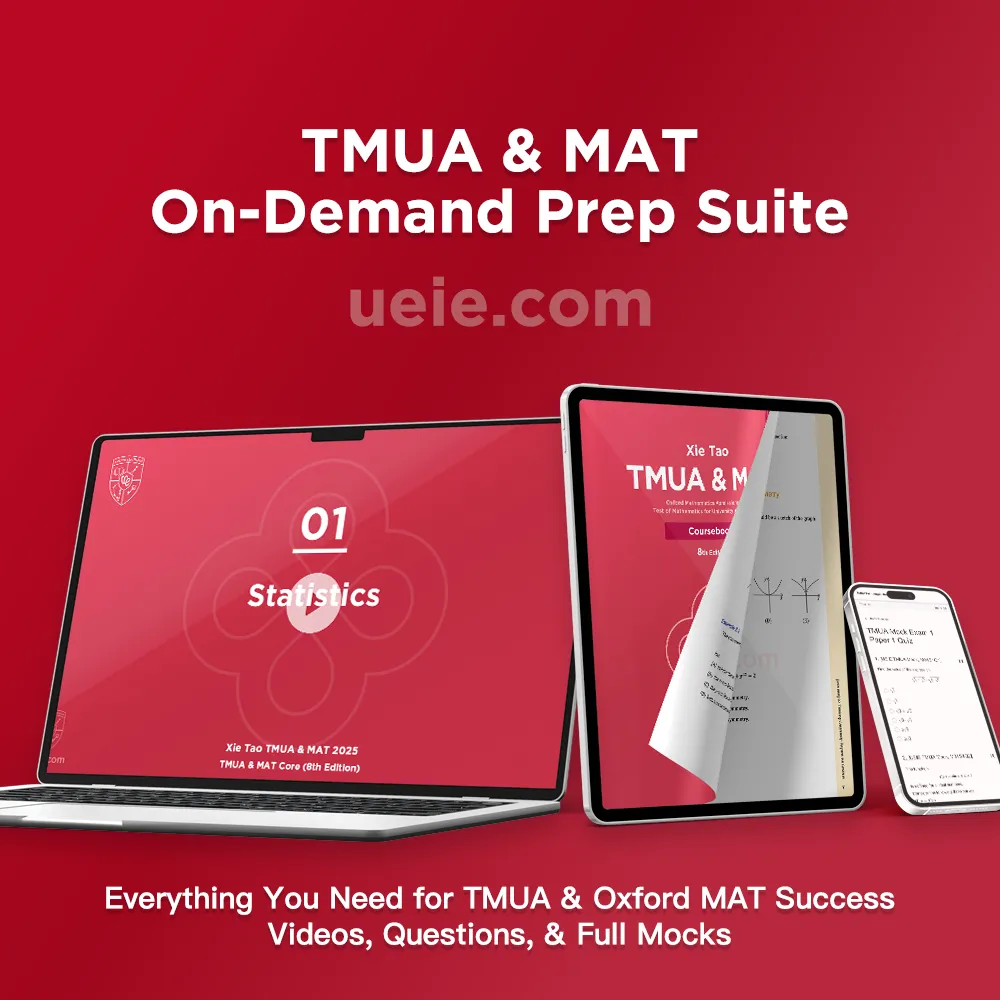
TMUA & MAT On-Demand Prep Suite
The TMUA & MAT On-Demand Prep Suite is your all-in-one solution for exam success. This comprehensive package combines Xie Tao’s expert video lectures, a massive bank of 1360 practice questions with detailed solutions, and 12 full-length mock exams that mirror the real test. Prepare thoroughly, build confidence, and achieve your target score.US$1 278 – US$1 847Price range: US$1 278 through US$1 847
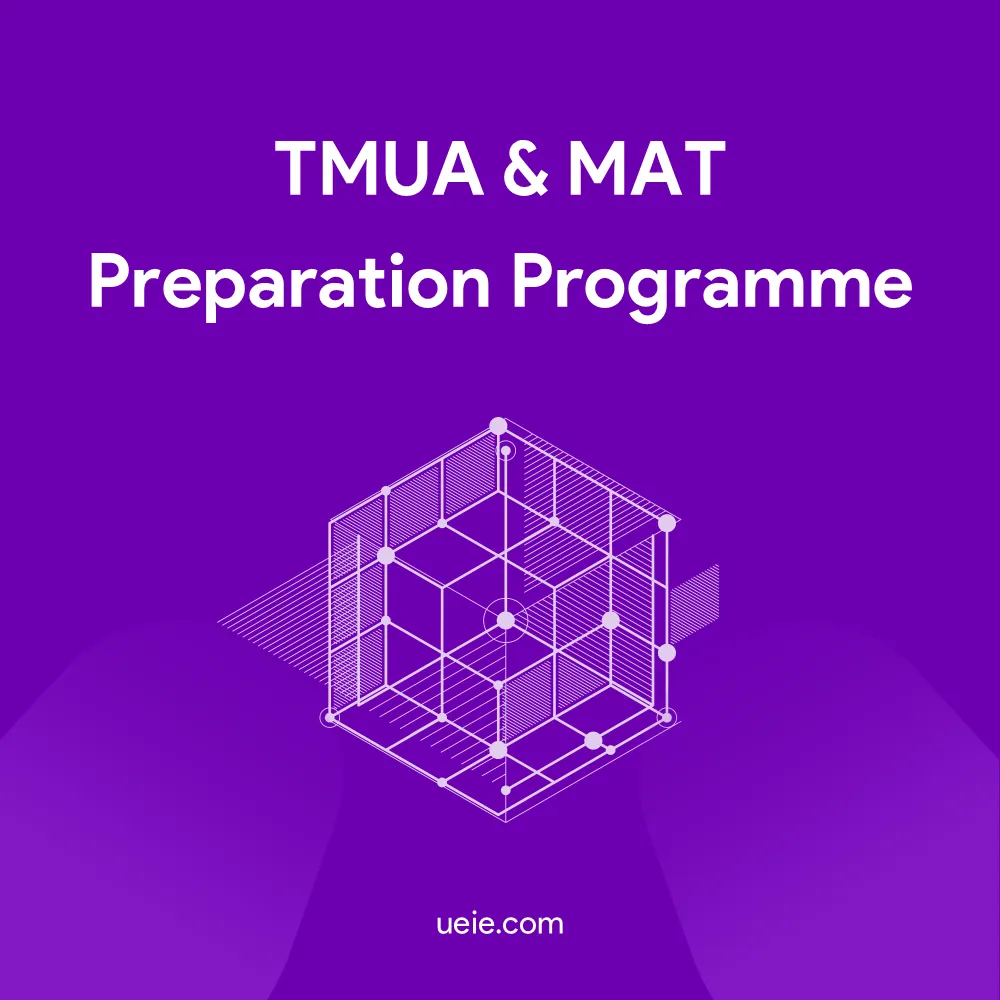
TMUA & MAT Preparation Programme
Prep for both and save time. This all-in-one programme provides 130 periods, 9 unseen TMUA mocks, 3 predictive papers, and 6 MAT mocks, helping you systematically master both exams. Click to view the bundle.US$3 102 – US$12 777Price range: US$3 102 through US$12 777
The greatest value of such resources lies in their optimised design, which already incorporates the ‘combination’ and ‘separation’ learning paths and training content based on the similarities and differences between the two examinations. They can clearly guide students on what to learn first, what to practise subsequently, and how to practise most efficiently, thereby averting the potential waste of time and energy that might arise from students’ own trial-and-error efforts. For those pursuing highly efficient preparation, this is an exceedingly judicious choice.
3. Reassurance for Parents
Some parents may harbour concerns: Will preparing for both simultaneously result in neither being mastered thoroughly? On the contrary, a scientific approach to joint preparation is a more intelligent learning strategy. It does not merely amalgamate the content of the two examinations; rather, by integrating the common foundational components, it conserves precious time and energy, enabling the child to address the unique difficulties and skill requirements of each examination with greater composure and focus. This is a structured, efficiency-oriented method, the objective of which is to maximise the outcome of the preparation.
V. Conclusion: Bid Farewell to Indecision, Progress Efficiently
In summary, whilst the TMUA and MAT differ in their assessment styles and specific question types, their close ‘intrinsic connection’ in terms of knowledge base and core competency requirements makes joint preparation not only entirely feasible but, for many ambitious students, an intelligent path capable of genuinely enhancing efficiency and achieving a ‘1+1>2’ effect.
The key to success lies in employing appropriate methodology: fully leveraging their commonalities to efficiently establish a solid foundation, whilst also clearly recognising their differences and undertaking precise, specialised skills training.
It is hoped that the analysis herein will help to dispel any doubts and instil confidence in your forthcoming preparation planning. It is advisable to consider adopting structured, systematic joint preparation schemes and high-quality resources to ensure a smoother and more efficient preparation journey.
Want to learn more? Please see:

TMUA Prep Hub
Master the TMUA with UEIE’s Prep Hub! We offer everything you need to succeed: in-depth video lecture series, extensive practice question bank, realistic full-length mock exams, expert guides, and insightful data analysis.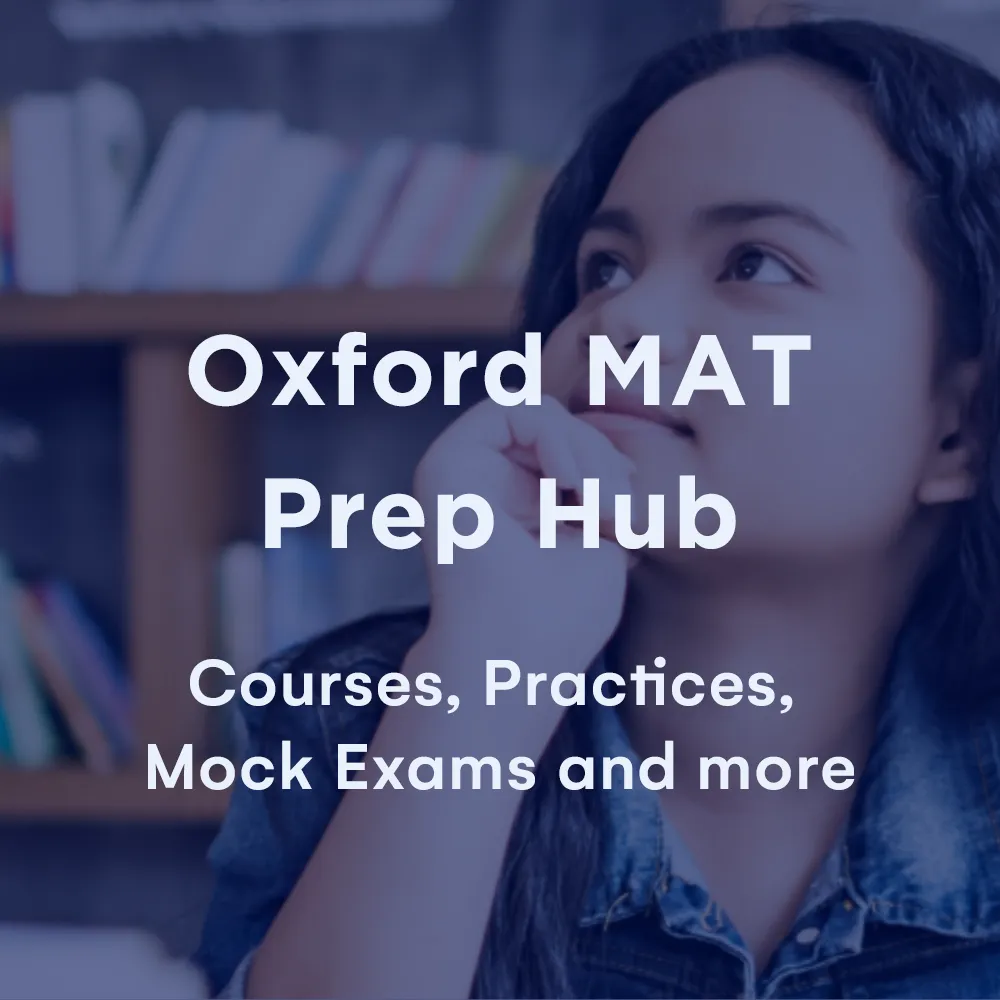
Oxford MAT Prep Hub
Master the Oxford MAT with UEIE’s Prep Hub! We offer everything you need to succeed: in-depth video lecture series, extensive practice question bank, realistic full-length mock exams, expert guides, and insightful data analysis. -

STEP vs TMUA vs MAT: A Strategic Comparison to Choose Your Maths Test
If you intend to apply for mathematics, computer science, or economics-related courses at top G5 universities in the UK, such as Oxbridge or Imperial College, you may need to face one of three examinations: STEP, TMUA, or MAT. The requirements for these examinations vary, often leaving applicants perplexed: STEP vs TMUA vs MAT — Which one should I prepare for? What are the differences between them? Which is most suitable for me?
Choosing the right examination and planning your preparation schedule appropriately can help you avoid detours and improve efficiency. This article will provide you with a clear and comprehensive comparative guide, analysing the core differences between STEP, TMUA, and MAT in terms of assessment focus, examination format, knowledge requirements, difficulty level, style, and specific university requirements. After reading this article, you will be better able to determine which examination best matches your target institutions and personal circumstances, thereby enabling you to make the most informed choice.
I. STEP vs TMUA vs MAT: Overview of the Three Examinations
To begin with, and before delving into a detailed comparison, the table below provides a quick outline of the core information for each of the three examinations – STEP, TMUA, and MAT – to help you form a basic impression.
Dimension Cambridge STEP TMUA Oxford MAT Managing Body University of Cambridge UAT-UK University of Oxford Exam Delivery Provider OCR Examination Board Pearson VUE Pearson VUE Answering Format Pen-and-paper Online computer-based Online computer-based Question Types Extended answer questions Multiple-choice questions Multiple-choice + Extended answer questions Key Characteristics Long, challenging questions; requires Further Mathematics knowledge; emphasises proof process. High time pressure; requires A-Level Mathematics; assesses speed, precision, logical judgment. Based on A-Level Mathematics, does not require Further Mathematics; emphasises flexibility of thought. Typical Universities / Courses Requiring Exam - Mandatory for Mathematics at Cambridge
- Accepted or recommended by Imperial/Warwick etc.
- Mandatory for Computer Science, Economics at Cambridge & certain courses at Imperial/LSE/UCL
- Accepted/alternative at Warwick/Durham etc.
- Mandatory for Mathematics/Computer Science related courses at Oxford.
Keywords Depth, Rigour, Proof, Cambridge Speed, Accuracy, Logical Reasoning, Wide Applicability Logic, Problem Solving, Flexibility of Thought, Oxford II. STEP vs TMUA vs MAT Comprehensive Comparison: Analysis of Key Dimensions
Having gained a basic impression of the three examinations, this section will provide a more comprehensive and detailed analysis, comparing the differences between STEP, TMUA, and MAT across multiple key dimensions.
1. Assessment Objectives and Focus
- Cambridge STEP: The core objective is to test profound mathematical thinking and rigorous proof-writing ability. Specifically, it requires students not only to solve problems but also to clearly and completely justify every step of their solution process, akin to conducting a small mathematical investigation. Therefore, it is suited for demonstrating a solid mathematical foundation and logical reasoning capability.
- TMUA: The core objective is to test the fluent application of mathematical knowledge and the agility of mathematical reasoning. It demands that students, under strict time constraints, quickly and accurately recall foundational knowledge (primarily AS Level) and make logical judgments. It is suited for demonstrating a solid foundation and efficient cognitive responsiveness.
- Oxford MAT: The core objective is to test a deep understanding of mathematical concepts and creativity in solving novel problems. It requires students to flexibly apply foundational knowledge (primarily A Level) and find breakthroughs via logical analysis in situations without fixed ‘routines’. It is suited for demonstrating flexibility of thought and mathematical intuition.
2. Applicable Universities and Course Requirements
University admissions policies may change annually. The table below is for reference only, based on information current as of 2025. Applicants for 2026 entry and beyond must consult the official websites of their target universities and courses for the latest, definitive information.
Dimension Cambridge STEP TMUA Oxford MAT Main Mandatory Requirements (Uni/Course) - University of Cambridge: Mathematics
- University of Cambridge: Computer Science, Economics
- Imperial College: Mathematics Dept., Economics, Finance & Data Science, some Computer Science Dept. courses etc.
- LSE: Economics, Econometrics, Mathematics & Economics etc.
- UCL: Economics
- University of Warwick: Mathematics, Statistics, Computer Science, Economics etc.
- Durham University: Some courses
- University of Oxford: Mathematics, Computer Science related courses
Recommended / Accepted Alternative / Other - University of Warwick: Can be substituted with TMUA/AEA
- Imperial College: Can supplement TMUA in special circumstances
- UCL: Can be used to lower A Level requirements, or substituted with AEA
- University of Bath etc.: May accept/recommend
- University of Oxford: Participation officially encouraged
- Warwick: Mathematics, Statistics accept STEP/AEA as alternatives
- Imperial, Warwick etc.: no longer require or accept MAT
Summary Positioning Core requirement for Cambridge Mathematics, accepted by some other institutions. Widest applicability, covering Maths, Comp Sci, Economics at many top institutions. Core requirement for University of Oxford. 3. Examination Format and Structure
Dimension Cambridge STEP TMUA Oxford MAT Examination Mode Pen-and-paper Paperless computer-based Paperless computer-based Question Types Extended answer questions Multiple-choice questions Multiple-choice + Extended answer questions Paper Construction Globally uniform paper Question bank based (papers may differ slightly by region/session) Globally uniform paper Number of Questions STEP 2 & STEP 3: 12 questions per paper, answer any 6. Papers 1 & 2: 20 questions each, total 40 multiple-choice, answer all. Total 25 multiple-choice + 2 extended answer (keyboard input), answer all. Examination Duration 3 hours / per paper 2.5 hours (75 mins each for Paper 1 & 2) 2.5 hours Permitted Aids Calculators, formula sheets, dictionaries NOT allowed. Calculators, formula sheets, dictionaries NOT allowed. Calculators, formula sheets, dictionaries NOT allowed. 4. Marking Scheme and Result Presentation
Dimension Cambridge STEP TMUA Oxford MAT Scoring Method Only the best 6 questions scored (20 marks each), total 120. All 40 multiple-choice questions scored (1 mark each), raw total 40. All questions scored (MCQ weighted by difficulty, total 70; Extended answers 15 marks each with partial credit), total 100. Result Format Grades: S, 1, 2, 3, U (S highest) Standardised score: 1.0 – 9.0 (one decimal place) Raw score: 0 – 100 Score Thresholds Variable, adjusted annually based on paper difficulty and candidate performance. No ‘pass mark’; score significance depends on application context. No fixed ‘offer threshold’; Oxford uses holistic assessment, score significance interpreted against historical data. Competitiveness Reference Cambridge typically requires Grade 1 or S; other institutions may require Grade 2 or above. Generally, 6.5+ considered competitive; 7.0+ strong; 8.0+ highly competitive. Oxford offer-holders often average around 70; recent trend suggests rising scores, mainland Chinese students may need higher for interview. 5. Comparison of Knowledge, Difficulty, and Style
Dimension Cambridge STEP TMUA Oxford MAT Knowledge Requirement STEP 2: A Level Maths + AS Further Maths
STEP 3: A Level Maths + A Level Further MathsPrimarily based on A Level Maths + some GCSE Maths Primarily based on A Level Maths Further Mathematics Required Not required Not required Question Style Depth & Rigour: Assesses deep understanding and complex application of knowledge, emphasising rigorous, multi-step proof processes. Structured, progressive questions, akin to mini mathematical research. Speed & Application: Assesses fluent mastery and rapid, accurate application of foundational knowledge, plus agility in logical reasoning. Short, fast-paced questions focused on reaction speed and calculation/judgment precision. Flexibility & Creativity: Assesses profound understanding of basic concepts and flexible application in novel contexts, emphasising logical analysis and creative problem-solving. Cleverly designed questions, sometimes like mathematical puzzles, prioritising insightful approaches. Source of Difficulty Depth and breadth of knowledge (esp. Further Maths); high standard for proof rigour; question length and computational complexity; requires problem-solving stamina. Extreme time pressure (avg. 3.5 mins/question); demands exceptional speed and accuracy in calculation/judgment; requires swift judgement in logical reasoning questions. Novelty/’non-routine’ nature of questions; demands depth and rigour in logical thinking; requires creative application of basic knowledge to unfamiliar scenarios. Difficulty Rating ★★★★★ ★★★ ★★★☆ Comparison with A-Level Far exceeds A-Level, particularly in depth of thought, proof requirements, and breadth of knowledge (incl. Further Maths). Significantly exceeds A-Level, mainly in demands for speed, precision, and logical application. Far exceeds A-Level, especially in depth of logical reasoning, creativity in problem-solving, and flexibility of thought. Summary Points
- Knowledge Threshold: STEP has mandatory Further Mathematics requirements, the highest amongst the three. The knowledge base for TMUA and MAT is relatively closer to standard A Level.
- Core Challenge: STEP’s difficulty lies in depth and proof; TMUA’s in speed and efficiency; MAT’s in thinking and novelty.
- Difficulty Consensus: All three examinations are considerably more challenging than A Level examinations, requiring a higher level of mathematical proficiency and ability.
III. How to Choose: Selecting the Most Suitable Examination for You
Having understood the detailed differences between the three examinations, the question now is: which examination(s) do you need to prepare for? The following steps will guide you in making an initial determination:
1. Step 1: Identify Mandatory Requirements
This is the decisive starting point for choosing an examination, overriding all other factors.
Clarify Targets: Clearly identify all the universities and specific courses you plan to apply for.
Verify Official Websites: Visit the official admissions pages for each of these university courses one by one. First, find and confirm the latest, most accurate entrance examination requirements for your intended year of entry (e.g., 2026). Crucially, pay attention to keywords such as ‘Required,’ ‘Recommended,’ ‘Accepted Alternative,’ etc..
Determine Mandatory Exams: Based on the official information, determine which examinations you must take.
- Applying to Oxford Mathematics/Computer Science etc. → MAT is mandatory.
- Applying to Cambridge Mathematics → STEP is mandatory.
- Applying to Cambridge Computer Science/Economics → TMUA is mandatory.
- Applying to Imperial/LSE/UCL/Warwick etc. for Mathematics, Computer Science, Economics → Check specific requirements; TMUA is often mandatory, but note if alternatives are accepted.
Completing this step clarifies the examination hurdles you must overcome. Consequently, for some students, the result might be needing to prepare for only one examination; in contrast, for others, it might mean facing the challenge of two or even three examinations simultaneously.
2. Step 2: When Options Exist, Match with Personal Attributes
You only need to consider this second step under the following circumstances:
- University Offers Multiple Options: Your desired university/course accepts more than one examination result (e.g., Warwick accepts TMUA/STEP/AEA).
- Saving Preparation Time and Effort: You are required to take multiple examinations and need to judge which one better aligns with your natural strengths to allocate preparation effort more reasonably.
- Considering Optional Exams for Enhancement: You are considering taking a non-mandatory examination (e.g., Oxford encourages STEP) to strengthen your application competitiveness.
In such cases, consider the following personal factors to determine which examination allows you to best leverage your strengths:
Academic Background and Strengths
- Is Further Mathematics your comfort zone, and do you enjoy rigorous proofs? → STEP might be a good fit.
- Is your foundational mathematics exceptionally solid, are you fast and accurate in calculations, and is your logic clear? → TMUA’s requirements might highly match your abilities.
- Can you demonstrate profound understanding without relying on Further Mathematics, are you flexible in thinking, and adept at clever solutions? → MAT’s style might suit you better.
Learning and Examination Preferences
- Prefer immersive problem-solving on a few challenging questions? → STEP’s format (choose 6 from 12).
- Prefer fast-paced responses to a variety of questions (multiple-choice)? → TMUA’s format.
- Prefer logical puzzles and showcasing thought processes (multiple-choice + extended answers)? → MAT’s format.
Available Preparation Time
- Ample time, able to commit long-term (9-12 months+)? → Better equipped to handle STEP’s depth requirements.
- Relatively limited preparation time, needing efficient improvement? → Preparation for TMUA or MAT (especially a TMUA+MAT combination) might offer higher time efficiency.
3. Summary
The primary basis for choosing an entrance examination is the undeniable mandatory requirement set by the target university. Beyond that, personal academic strengths, learning preferences, and time planning are important considerations for making a choice (when options exist) or optimising your preparation strategy.
IV. Addressing Multiple Challenges: Common Examination Combinations and Preparation Strategies
If you plan to apply simultaneously to several top universities (e.g., Oxbridge, Imperial, LSE) for mathematics, computer science, or economics courses, you will likely need to prepare for multiple entrance examinations. Below are suggestions for preparation timelines and strategies for common combinations of these three examinations.
1. STEP + TMUA Combination
Applicable Universities and Courses: Simultaneously applying to Cambridge University and other G5 universities for mathematics-related courses.
Suggested Preparation Period: 12 months or more. Sufficient time is needed to separately hone the depth required for STEP and the speed for TMUA.
Core Preparation Strategy:
- Specialised Training: Independent, high-intensity specialised practice sessions must be arranged to address STEP’s depth of proof and Further Mathematics, alongside TMUA’s timed multiple-choice answering, speed, and precision.
- Style Switching: Focus on adaptability training to switch between two vastly different problem-solving styles and thinking modes.
2. TMUA + MAT Combination
Applicable Universities and Courses: Simultaneously applying to Oxford University and other G5 universities for mathematics or computer science related courses.
Suggested Preparation Period: Preparation time varies depending on mathematical foundation, generally 5-10 months is recommended.
Core Preparation Strategy:
- Integrated Foundation: Leverage the high degree of knowledge overlap to consolidate foundational review and core competency training.
- Differentiated Training: Specifically strengthen TMUA’s timed multiple-choice speed and techniques, alongside MAT’s logical depth and extended answer argumentation.
- Resource Utilisation: Consider using resources specifically targeting this combination (e.g., the UEIE TMUA+MAT series) to maximise preparation efficiency.
3. STEP + TMUA + MAT Combination
Applicable Universities and Courses: Uncertain initially whether applying for Cambridge or Oxford mathematics, or wishing to enhance mathematical proficiency through STEP preparation, ultimately deciding to apply for Oxford and other G5 universities for mathematics or computer science related courses.
Suggested Preparation Period: 18 months or more. An extreme challenge to time, ability, and perseverance.
Core Preparation Strategy:
- Realistic Assessment: Prudently evaluate your own abilities and goals, setting feasible expectations.
- Intensive Planning: Develop an extremely detailed plan integrating the requirements of all three, potentially requiring trade-offs in some areas.
- Seek Support: Strongly recommended to seek guidance from experienced professionals and efficiently utilise all available resources.
- Focus on Core: Within extremely limited time, prioritise ensuring absolute solidity in core knowledge and common competencies before undertaking the most efficient training for specialised skills.
V. Conclusion and Action Recommendations
Through the comprehensive comparison in this article, it is hoped you now have a clearer understanding of the three entrance examinations: STEP, TMUA, and MAT. Let us summarise the core points:
- Cambridge STEP: Characterised by its depth, rigour, and requirement for Further Mathematics, it focuses on assessing students’ ability to undertake complex mathematical proofs and deep thinking, serving as a hallmark threshold for courses like Cambridge Mathematics.
- TMUA: With its high demands on speed, accuracy, and logical reasoning, it focuses on assessing students’ ability to fluently apply core mathematical knowledge under time pressure, having the broadest range of applications.
- Oxford MAT: By examining flexibility of thought, logical depth, and creative application of foundational knowledge, it focuses on assessing students’ mathematical potential and ability to solve novel problems, serving as Oxford University’s distinctive selection tool.
So, having clarified these differences, what should you do next?
First Priority
Verify Official Requirements! To reiterate, the final decision on which examination(s) to take rests with the universities and courses you are applying to. You need to log onto the official admissions websites of your target institutions to understand the latest, most accurate entrance requirements. Any non-official information (including this article) can only serve as a reference.
Gain In-depth Understanding of Relevant Exams
After determining the examination(s) you need to take, it is recommended you read my detailed guides and preparation guides for the relevant examinations to obtain more in-depth information:
Focus on Specific Combinations
If you find you need to take both TMUA and MAT, you can further read my analysis on preparation strategies for this combination:
Understand the Registration Process
Once you have decided on the examination(s), familiarise yourself with and prepare for the registration procedures in a timely manner:
Plan and Prepare Early
Regardless of which examination you choose, thorough preparation is key to success. Utilise the relevant preparation guides, formulate a detailed preparation plan early on, and put it into action. If needed, consider leveraging high-quality preparation resources, such as:

TMUA Prep Hub
Master the TMUA with UEIE’s Prep Hub! We offer everything you need to succeed: in-depth video lecture series, extensive practice question bank, realistic full-length mock exams, expert guides, and insightful data analysis.
Oxford MAT Prep Hub
Master the Oxford MAT with UEIE’s Prep Hub! We offer everything you need to succeed: in-depth video lecture series, extensive practice question bank, realistic full-length mock exams, expert guides, and insightful data analysis.
Cambridge STEP Prep Hub
Master the Cambridge STEP with UEIE’s Prep Hub! We offer everything you need to succeed: in-depth video lecture series, extensive practice question bank, expert guides, and insightful data analysis.Choosing the correct entrance examination is a significant step towards your dream university. I hope the comparative analysis in this article illuminates the path ahead, helping you make the decision best suited to you. Wishing you smooth preparation and successful applications!
-

2025 G5 Admissions Tests: Dates, Requirements & Preparation Timeline

I. Admissions Test Reforms: Navigating Your Choices
The landscape of admissions tests for Oxbridge and other G5 universities has been constantly evolving. Recently, several tests have been discontinued, while new ones like ESAT, UCAT, and TARA have emerged. Adding to the complexity, different universities often have varying test requirements even for similar courses, creating significant hurdles for applicants.
Strong performance in these admissions tests is vital for receiving an offer from a G5 university. For students and their parents, keeping up with the latest requirements, selecting the appropriate exams, and preparing efficiently pose considerable challenges.
This guide breaks down the 2025 admissions test schedule and specific course requirements for Oxbridge and G5 universities. Our goal is to assist applicants and their families in defining clear application targets, mapping out a practical preparation timeline, and focusing their efforts strategically to boost their chances of success.
II. Overview of 2025 Oxbridge & G5 Admissions Tests
As soon as universities officially released their 2025 admissions test details, we carefully compiled the following tables. They summarise the name, date, subjects/content covered, and applicable courses for each exam, aiming to provide a clear and quick understanding of this year’s Oxbridge and G5 test arrangements.
Tests for Cambridge, Imperial College, UCL & LSE
Test Name Test Date(s) Subjects/Content Applicable Universities Applicable Courses STEP STEP 2: 11 June 2025 STEP 3: 16 June 2025 2026 dates TBC Mathematics, Further Mathematics Cambridge University Mathematics, Mathematics and Physics ESAT 9 Oct 2025 (Not for mainland China, HK, Macau candidates) 10 Oct 2025 6-7 Jan 2026 (Not for Cambridge candidates) Mathematics 1, Mathematics 2, Physics, Chemistry,Biology Cambridge University Engineering, Chemical Engineering & Biotechnology, Natural Sciences, Veterinary Medicine Imperial College Aeronautics, Chemical Eng, Civil & Environmental Eng, Dyson Design Eng, Elec & Electronic Eng, Mechanical Eng, Physics UCL Electronic & Electrical Engineering TMUA 13 Oct 2025 (Not for mainland China, HK, Macau candidates) 14 Oct 2025 8-9 Jan 2026 (Not for Cambridge candidates) Mathematics Cambridge University Computer Science, Economics Imperial College Computing courses, Maths courses, Economics, Finance & Data Science LSE Economics (Required), Econometrics & Mathematical Economics (Required), Maths & Economics (Recommended) UCL Economics TARA 15-16 Oct 2025 12-13 Jan 2026 Critical Thinking, Problem Solving, Effective Communication UCL Computer Science, Mathematical Computation, Robotics & AI, European Social & Political Studies, Int’l Social & Political Studies, Management Science, Social Sciences, Sociology & Data Science, Sociology UCAT 7 July to 26 Sept 2025 Verbal Reasoning, Decision Making, Quantitative Reasoning Cambridge University Medicine Oxford University Medicine UCL Medicine LNAT 1 Sept to 15 Oct 2025 Reading Comprehension, Essay Writing Cambridge University Law Oxford University Law, Law with European Law LSE Law UCL Law Oxford University’s Specific Admissions Tests
Test Name Test Date(s) Subjects/Content Applicable Courses MAT 22-23 Oct 2025 Mathematics Mathematics, Mathematics & Philosophy, Mathematics & Computer Science, Computer Science, Computer Science & Philosophy PAT 22-23 Oct 2025 Mathematics, Physics Physics, Physics & Philosophy, Engineering, Materials Science TSA 21-24, 27 Oct 2025 Critical Thinking, Problem Solving Section 1 only: Economics & Management, Experimental Psychology, History & Economics, Human Sciences, PPL (Psychology, Philosophy & Linguistics) Sections 1 & 2: PPE (Philosophy, Politics & Economics) AHCAAT 24 Oct 2025 Critical Academic Writing, Analysis of Ancient History Materials Classical Archaeology and Ancient History BMSAT 21-24, 27 Oct 2025 Mathematics, Physics, Chemistry, Biology Biomedical Sciences CAT 22-24 Oct 2025 Latin Translation, Greek Translation, Classical Languages Aptitude Classics, Classics & English, Classics & Modern Languages, Classics & Asian and Middle Eastern Studies MLAT 24 Oct 2025 8 Languages including French, Language Aptitude, Philosophy European & Middle Eastern Languages, Classics & Modern Languages, English & Modern Languages, History & Modern Languages, Modern Languages, Modern Languages & Linguistics, Philosophy & Modern Languages PhilAT 24 Oct 2025 Philosophical Reasoning Philosophy and Theology Tests Cancelled in 2024 and 2025 and Their Replacements:
- Oxford’s HAT (History Aptitude Test) – No replacement
- Cambridge’s ENGAA (Engineering Admissions Assessment) & NSAA (Natural Sciences Admissions Assessment) – Both replaced by ESAT
- BMAT (BioMedical Admissions Test) – Replaced by UCAT or BMSAT (depending on course/university)
Test Format
With the exception of Cambridge’s STEP exams, all the tests mentioned above are delivered online as computer-based exams. They are administered by Pearson VUE at their global test centres.
III. Comparative Analysis of Oxbridge & G5 Test Requirements by Course
This section provides a side-by-side comparison of admissions test requirements for five major subject categories: Mathematics, Computer Science, Engineering, Natural Sciences (Physics), and Economics.
We will focus specifically on:
- Required Tests: Which admissions tests does each university require for the same course?
- Test Difficulty: What is the approximate difficulty level of each test?
- Target Scores (Reference): Apart from Cambridge’s STEP, which has defined grade requirements, other tests do not have official ‘cut-off scores’. The reference scores provided in the tables below are not official data and do not necessarily represent the minimum scores achieved by admitted students.
1. Admissions Test Requirements for Mathematics Courses
University Test Difficulty Target Score (Reference) Cambridge University STEP Hard Grade 1 or above Oxford University MAT Relatively Hard 75+ Imperial College TMUA Medium 6.5+ LSE TMUA Medium 7.0+ Common Test Combinations for Oxbridge & G5 Mathematics Applicants
University Combination Tests Suggested Preparation Time Cambridge + Other G5/Universities STEP+TMUA STEP: 6+ months + TMUA: 2-3 months OR STEP: 3-6 months + TMUA: 3-4 months Oxford + Other G5/Universities MAT+TMUA (STEP optional) 3-5 months (up to 10 months max) Imperial / LSE / UCL + Other Universities TMUA 4-6 months (up to 10 months max) 2. Admissions Test Requirements for Computer Science Courses
University Test Difficulty Target Score (Reference) Cambridge University TMUA Medium 7.5+ Oxford University MAT Relatively Hard 80+ Imperial College TMUA Medium 7.0+ UCL TARA Medium Unknown (New for 2025 entry) Common Test Combinations for Oxbridge & G5 Computer Science Applicants
University Combination Tests Suggested Preparation Time Cambridge + Other G5/Universities TMUA 3-5 months (up to 10 months max) Oxford + Other G5/Universities MAT+TMUA (STEP optional) 3-5 months (up to 10 months max) Imperial + Other Universities TMUA 4-6 months (up to 10 months max) Imperial / UCL + Other Universities TMUA+TARA 4-6 months (up to 10 months max) 3. Admissions Test Requirements for Engineering Courses
University Test Difficulty Target Score (Reference) Cambridge University ESAT Medium Average 7.0+ across 3 modules Oxford University PAT Relatively Hard 75+ Imperial College ESAT Medium Average 6.5+ across 3 modules UCL ESAT Medium Unknown (New for 2025 entry) Common Test Combinations for Oxbridge & G5 Engineering Applicants
University Combination Tests Suggested Preparation Time Cambridge + Imperial / UCL ESAT 3-5 months (up to 10 months max) Oxford + Imperial / UCL ESAT+PAT 3-5 months (up to 10 months max) Imperial / UCL ESAT 4-6 months (up to 10 months max) 4. Admissions Test Requirements for Natural Sciences (Physics) Courses
University Test Difficulty Target Score (Reference) Cambridge University ESAT Medium Average 7.0+ across 3 modules Oxford University PAT Relatively Hard 75+ Imperial College ESAT Medium Average 6.5+ across 3 modules Common Test Combinations for Oxbridge & G5 Natural Sciences (Physics) Applicants
University Combination Tests Suggested Preparation Time Cambridge + Imperial ESAT 3-5 months (up to 10 months max) Oxford + Imperial ESAT+PAT 3-5 months (up to 10 months max) Oxford PAT 3-5 months (up to 10 months max) Imperial ESAT 4-6 months (up to 10 months max) 5. Admissions Test Requirements for Economics Courses
University Test Difficulty Target Score (Reference) Cambridge University TMUA Medium 7.0+ Oxford University TSA Medium PPE & E&M: 85+; Others: 70+ Imperial College TMUA Medium 6.5+ LSE TMUA Medium 7.0+ UCL TMUA Medium 6.5+ Common Test Combinations for Oxbridge & G5 Economics Applicants
University Combination Tests Suggested Preparation Time Cambridge + G5 + Others TMUA 4-6 months (up to 10 months max) Oxford TSA 4-6 months (up to 10 months max) Imperial / LSE / UCL + Others TMUA 4-6 months (up to 10 months max) IV. Admissions Test & Interview Preparation Timeline
This section offers a general timeline for preparing for admissions tests and interviews, designed to help candidates plan effectively. Please note this is just a suggested timeline; your specific schedule should be adjusted based on your individual circumstances and the requirements of your target universities.
Time Period Main Tasks Key Focus Areas Feb – Jun Research, Skills Training 1. Read the latest admissions requirements on the Oxbridge/G5 university websites carefully.
2. Decide on target courses and the required tests.
3. Gather official materials: syllabuses, sample questions, past papers.
4. Understand test formats, question types, difficulty levels.
5. Create a detailed preparation plan or choose suitable prep courses/materials.
6. Strengthen maths and critical thinking skills for tests and interviews.Jun – Sep Systematic Revision, Build Foundation 1. Review foundational knowledge for each test subject based on the syllabus.
2. Use structured courses or materials for topic-specific practice.
3. Complete examples and exercises to consolidate knowledge.
4. Start attempting past papers (if available) to understand question styles and difficulty.October Final Push, Mock Exams 1. Take mock exams to familiarise yourself with timings and procedures.
2. Focus on weak areas identified in mocks.
3. Improve speed and accuracy in answering questions.
4. Get into optimal condition before sitting the actual tests.Oct – Dec Interview Preparation 1. Analyse test results (if released) to assess strengths and weaknesses.
2. Adjust application strategy if necessary (e.g., change target school/course – not applicable if UCAS submitted).
3. Intensify mock interview practice if you receive invitations.Jan – Jun (Following Year) Await Results, STEP Prep (if needed) 1. Wait for admission decisions.
2. If required, prepare for STEP exams (refer to STEP preparation guides). -

October 2024 TMUA & ESAT Scores and Explanations
The TMUA is a crucial benchmark for assessing a student’s mathematical ability. At the same time, the ESAT serves as a gateway to engineering and science-related courses at the University of Cambridge and Imperial College London. Both tests employ a 1.0 to 9.0 grading scale, similar to the IELTS, with higher TMUA and ESAT scores indicating a higher rank and stronger academic abilities in the relevant disciplines.
I. Unveiling the secrets behind the 2024 TMUA and ESAT scores
With this year’s adjusted scoring system, scores now provide a more intuitive reflection of a student’s rank, which is crucial for university admissions. So, where does your score stand? Let’s delve into a detailed analysis of the TMUA and ESAT score distribution.
TMUA

Math 1 ESAT
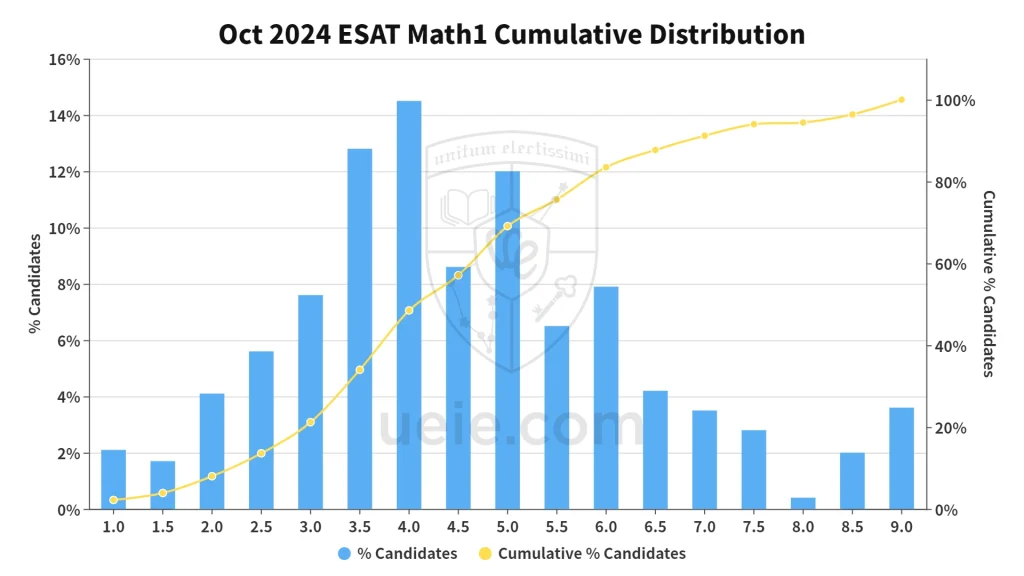
Math 2 ESAT
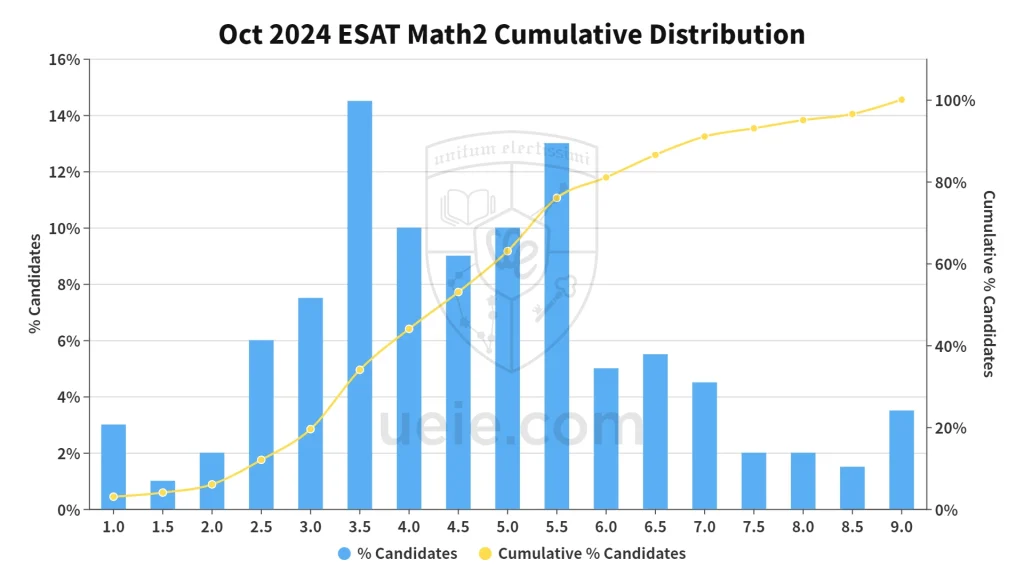
Physics ESAT
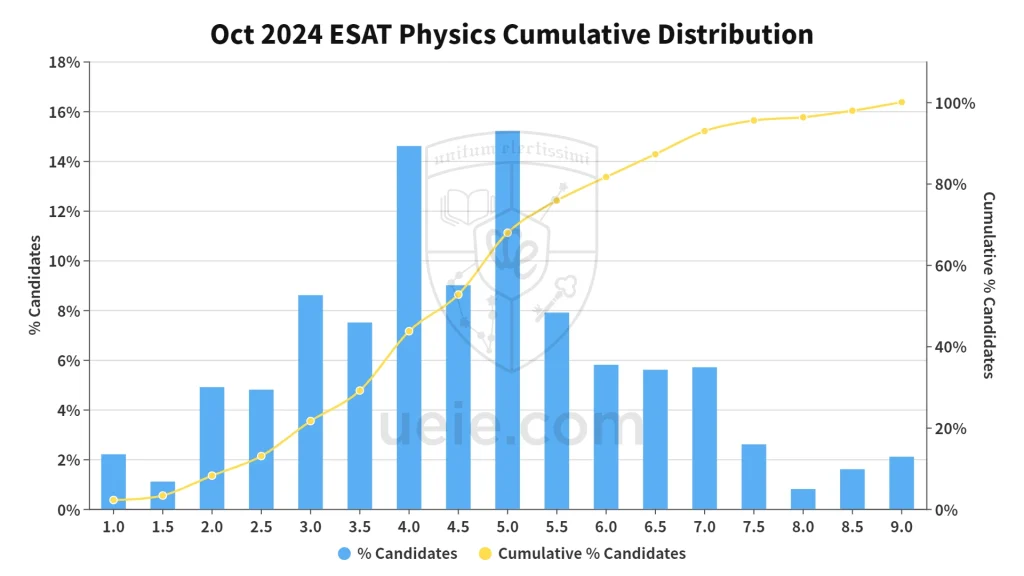
Chemistry ESAT
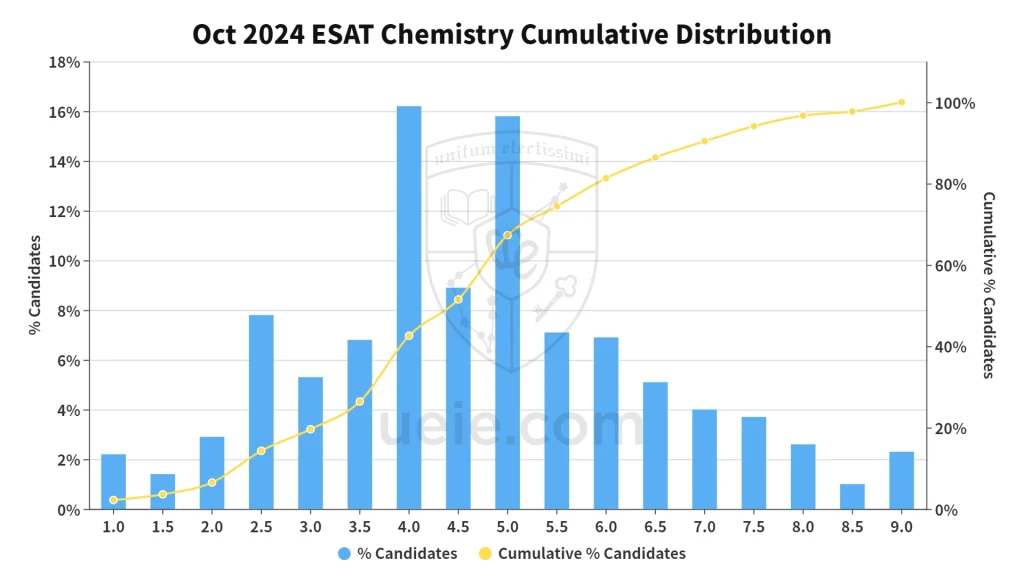
Biology ESAT
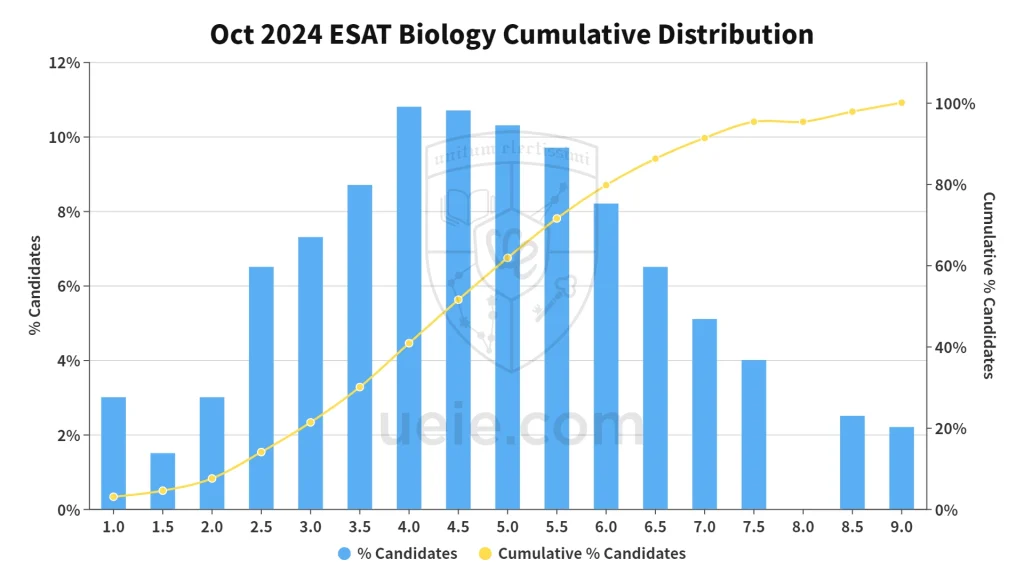
II. Why are there so many applicants who scored 9?
You may have noticed that the percentage of students scoring 9 is higher than those scoring 8 or 8.5! In some tests and subjects, the proportion of 9s even exceeds the combined proportion of 8.0 and 8.5 scores! There are several factors behind this phenomenon:
- A concentration of top students: Each subject attracts a group of exceptionally talented students who possess strong learning abilities and test-taking skills.
- Applicants for mathematics courses also sit the TMUA: Students applying for mathematics courses, who often have a strong aptitude for the subject, tend to score significantly higher on the TMUA compared to those applying for computer science or economics courses.
- Chinese students’ strength in mathematics: It’s well-known that Chinese students excel in mathematics and science. Their advantage in these subjects often gives them an edge in TMUA and ESAT, contributing to the higher proportion of 9 scores.
III. TMUA & ESAT scores: More than just correct answers
The TMUA and ESAT scores are reported on a scale that runs from 1 (low) to 9 (high). Contrary to popular belief, the score is not a simple reflection of the correct answer rate. The exams use multiple test papers, and the difficulty level can vary across different regions and exam times. Under this mechanism, merely counting correct answers cannot accurately assess a candidate’s true ability. Instead, the official scores, derived from rigorous statistical analysis and adjustments, provide a more precise ranking of candidates relative to their peers. Therefore, TMUA and ESAT scores are better understood as a comprehensive assessment of a candidate’s overall ability.
IV. Understanding your TMUA and ESAT score
Regardless of your score, maintain a positive attitude and keep striving for your dreams. Please note that the following interpretations are based on general trends and individual opinions, and should be taken as a reference only:
- 5.0 points: Congratulations! You’ve already outperformed half of the applicants.
- 6.5 points: You have a high chance of receiving an interview invitation from Cambridge. It’s time to start preparing for your interview.
- 7.5 points: Your chances of being admitted to Imperial College London and Cambridge are quite high.
- 8.5 and 9.0 points: If your personal statement and interview (if any) are strong, you can expect offers from top universities like Cambridge, Imperial College London, and LSE.
Of course, there are always exceptions. Factors such as luck, encountering an interviewer who is not a good fit, or performing poorly in an interview can influence the final outcome, even with a high TMUA or ESAT score. Remember, TMUA and ESAT scores are just one piece of the puzzle. Universities consider a variety of factors, including academic performance, personal statements, academic references, and interview performance, when making admissions decisions.
V. Next steps for your application
- Don’t get overly focused on the correlation between your score and the number of correct answers.
- Set realistic academic expectations based on your score.
- Check the official websites of universities for the latest requirements and updates on exam scores.
- Maintain a positive attitude and continue striving for your goals.
We hope the above information helps you better understand your TMUA and ESAT scores and aids in your future academic planning. Explore more preparation resources and posts:

TMUA Prep Hub
Master the TMUA with UEIE’s Prep Hub! We offer everything you need to succeed: in-depth video lecture series, extensive practice question bank, realistic full-length mock exams, expert guides, and insightful data analysis.
ESAT Prep Hub
Master the ESAT with UEIE’s Prep Hub! We offer everything you need to succeed: in-depth video lecture series, extensive practice question bank, realistic full-length mock exams, expert guides, and insightful data analysis. -

Conquer the TMUA: Speed & Accuracy Training for Top Maths Scores

Preparing for the TMUA test can often leave students feeling uncertain: How much preparation time is really needed? How can I effectively improve my speed and accuracy? Which study methods will work best for me? This TMUA Preparation Guide aims to address questions like these.
This guide draws on my years of practical experience and insights gained from coaching students for Oxbridge admissions tests and mathematics competitions. It focuses on how to set realistic preparation goals, develop the core mathematical abilities needed for TMUA, employ effective study strategies, plan your preparation time sensibly, make the best use of various resources, and sidestep common preparation pitfalls.
Before you dive into this guide, it’s a good idea to familiarise yourself with the basics of the exam by reading the TMUA Comprehensive Guide.
I. Setting Goals and Adjusting Your Mindset for TMUA Preparation
Getting started with your TMUA preparation first requires a clear sense of direction and some self-awareness. Setting sensible goals and having the right mindset will provide a solid foundation for your subsequent systematic preparation.
1. Clarify Target Requirements
What specific TMUA score does your chosen university and course require? Roughly what score range is considered competitive? This information essentially sets your target. Please carefully check your target university’s official website. Confirm the latest admission requirements for your application year. (You can find an overview of this information in Section III of the TMUA Comprehensive Guide.)
2. Conduct a Preliminary Self-Assessment
Before formally starting your systematic preparation, taking a diagnostic test (a baseline test) to gauge your starting point is crucial. This helps you to:
- Get a feel for the style of TMUA questions, the time pressure involved, and the actual difficulty level.
- Get an initial idea of your current mathematical proficiency and where the gaps lie compared to what TMUA requires.
3. How to Conduct a Diagnostic Test?
- Choosing a Test
- You could use official past papers from earlier years for a practice run.
- Recommended Approach: To help you get a more accurate and comprehensive self-assessment, based on years of research into the TMUA exam, I (Teacher Xie Tao) have created a dedicated Free TMUA Diagnostic Exam (online computer-based). This test reflects the latest TMUA syllabus and difficulty standards, designed to more effectively assess the core knowledge and skills needed for TMUA. Click the link below for more details and to take the test online.
- UEIE Free TMUA Diagnostic Exam
- Taking the Test
- Environment: Whichever paper you use, you should replicate real exam conditions as closely as possible (online computer-based or a quiet paper-based setting) and complete it on your own.
- Timing: Time Paper 1 and Paper 2 separately, sticking strictly to the 75-minute limit for each.
- Marking: Use the official marking scheme or the reference answers and marking guide provided with the diagnostic test to mark it objectively.
- Result Interpretation and Mindset: Remember, this initial score is just a baseline. The aim is to see where you stand, not to predict your final score. What matters is analysing your mistakes and identifying weak spots. Keep hold of your paper and analysis to track your progress later.
4. Setting Realistic TMUA Score Goals
Once you understand the target requirements and your own starting point, the next step is to set sensible, achievable TMUA preparation goals.
- Understanding Scores
Remember, TMUA’s 9.0-scale standard score needs to be seen in context – considering both university requirements and the overall competition. Please refer to the analysis of competitiveness across different score bands (e.g., 4.5, 7.0, 8.0+) in Section VI of the TMUA Comprehensive Guide to get a sense of where your target score sits. - Setting SMART Goals
Based on your diagnostic test results, target university requirements, and the time you can realistically commit, set goals that are Specific, Measurable, Achievable, Relevant, and Time-bound (SMART).
For instance: ‘My target is a score of 7.0 in the October TMUA test. To get there, over the next four months, I aim to consistently achieve a raw score of 32 (which converts to roughly 7.0) in practice mocks, while completing each paper within the 75-minute limit.’ - Balancing Ambition with Realism
Your goals need to be challenging enough to push you, but they must also be realistic given your assessment and available time, ensuring they are achievable with effort. Setting overly ambitious goals can easily lead to frustration, which can put you off. It’s also fine, and often necessary, to adjust your goals as you go along based on your progress.
II. Knowledge Foundation Required for TMUA Preparation
To prepare successfully for TMUA, you first need a clear picture of the knowledge the exam requires and understand how this applies to you (e.g., whether you’ve finished A Level Maths, or if you’re studying AP/IB).
1. TMUA Requirements regarding A Level Knowledge
As mentioned in Section VII, TMUA Syllabus Overview, of the TMUA Comprehensive Guide, the TMUA syllabus is primarily based on AS Level Mathematics content, along with some topics from GCSE Mathematics. Therefore, a solid grasp of the relevant AS and GCSE Maths content is essential.
2. Is it Necessary to Study A Level Further Mathematics in Advance?
No, it’s not required. The TMUA syllabus content doesn’t go beyond AS Maths and GCSE. However, in terms of deepening your mathematical thinking and getting ready for university interviews and future study, I strongly recommend studying A Level Further Mathematics if you have the time and capacity. Although not directly tested, the thinking skills and broader knowledge it develops are very useful for tackling some tricky TMUA problems and for your studies later on.
3. Is a Foundation in Mathematics Competitions Necessary?
It helps, but isn’t essential. Recently, some TMUA questions have shown a style and difficulty similar to maths competitions, occasionally using basic knowledge and methods common in competitions (like number theory, basic combinatorics, recursive thinking). Consequently, students with competition experience might have a slight advantage with certain difficult problems. For students without this background, don’t worry too much; the core of TMUA is still about applying the syllabus knowledge proficiently. However, during your preparation, if you come across questions with this flavour, it can be helpful to look into some basic competition concepts and techniques to broaden your skills.
4. Knowledge Alignment for Students from Different Curriculum Systems
Students studying AP or IB need to be aware of how the coverage differs and prepare accordingly.
- Advice for AP Students: AP Calculus AB or BC provides a good grounding for much of the pure maths needed for TMUA Paper 1 (especially calculus). However, be aware that TMUA expects more proficiency in sketching graphs by hand, whereas AP Calculus focuses more on using graphic calculators. Therefore, this might need specific practice.
- Advice for IB Students: Compared to the TMUA syllabus, IB Maths HL (both AA and AI) might not cover certain topics or go into the same breadth in pure maths and statistics. Furthermore, the emphasis on basic calculation and algebraic skills might also be different from what TMUA expects. Combined with the often demanding workload of the IB programme, students doing the IB often find TMUA more challenging.
III. Core Abilities Essential for High TMUA Scores
Mastering the required knowledge base is the first step, but to achieve a high score in TMUA, you also need to sharpen the following core skills, which are crucial given the test format (multiple-choice, tight time limits).
1. Calculation Speed and Precision
- Core Requirement
- You can’t use a calculator at any point in the TMUA, and the timing is extremely tight (less than 4 minutes per question on average). This presents a double challenge: you need speed, and critically, accuracy. In a multiple-choice format, any calculation slip-up can lead directly to lost marks, with no marks given for your working.
- Key Areas for Improvement
- Sharpening Basic Calculations: Get completely fluent with mental maths and written calculation techniques, especially for common values, formulas, algebraic manipulations, differentiation, integration, etc., until it’s almost second nature.
- Practising for Speed: Make a point of practising calculations under timed conditions without a calculator to improve how much you can accurately get done in a set time.
- Prioritising Precision: Get into the habit of being careful and checking your work, particularly with multiple-choice questions, where small errors can easily lead you to pick the wrong answer (a ‘distractor’).
2. Agility in Mathematical Reasoning
- Core Requirement
- Particularly in Paper 2 (Mathematical Reasoning), the test doesn’t just assess logical rigour, but also how quickly you can understand, apply, and evaluate mathematical logic and proofs under pressure. You need to quickly spot the logical connections within problems and identify valid arguments or common mistakes in reasoning.
- Key Areas for Improvement
- Understanding Logical Terms: Make sure you precisely understand terms like sufficient, necessary, if and only if, and negation.
- Recognising Patterns: Practise quickly spotting common proof structures (like the beginning of a proof by contradiction or the structure of induction) so you can grasp their core logic, even if you don’t need to write the full proof.
- Spotting Errors Quickly: Focus on practising how to spot potential logical flaws or incorrect steps in mathematical arguments.
- Getting to the Crux: Practise quickly identifying the main line of reasoning within complex descriptions or mathematical statements.
3. Multiple-Choice Test Strategies and Techniques
- Core Requirement
- As TMUA is purely multiple-choice, knowing effective test-taking strategies is just as important as knowing the maths itself. High scorers are often good at using different techniques flexibly to maximise their score in the limited time. Plus, when faced with unusual question types or phrasing, you need to be adaptable.
- Mastering Multiple-Choice Techniques:
- Process of Elimination: Get good at using elimination to quickly narrow down the possible answers.
- Using Special Cases: Try plugging in special values or considering extreme situations to check or rule out options.
- Estimation & Checking Units: For some questions, check if options are plausible by estimating the magnitude or checking the units.
- Working Backwards: Sometimes plugging the answers back into the question is quicker than working forwards to the solution.
- Managing Your Time:
- Quick Decisions: Practise quickly judging how hard a question is, so you can decide whether to tackle it now, leave it for later, or just make a guess. Avoid getting bogged down on difficult problems.
- Marking Questions: Mark questions you’re unsure about so you can come back to them if you have time at the end.
- Being Adaptable: Get better at handling unusual question types by practising problems from different sources and in different styles (including some competition-style problems).
- To sum up, scoring well in TMUA means being able to calculate quickly and accurately, reason logically and swiftly, and use smart multiple-choice strategies, all under pressure. Developing all three of these skills is key to your TMUA test preparation.
IV. Core Preparation Strategy and Resource Integration
1. Core Principle: Fluency, Precision, and Speed
Unlike STEP, which focuses on deep exploration, the core of TMUA test preparation is getting extremely fluent with the syllabus material and being precise and quick under pressure. Since only a limited number of official past papers have been released, simply drilling these isn’t enough. Successful preparation must be built on solid knowledge fluency, backed up by plenty of targeted practice to sharpen your speed, accuracy, and test-taking technique.
2. Phase 1: Building Fluency and Consolidating Knowledge
Goal
- Go through all the AS and GCSE Maths topics covered by the TMUA syllabus, making sure you know them fluently and can recall them quickly. The focus here is on strengthening your foundations and improving calculation speed and accuracy.
Actions and Resources
- Check the Syllabus: Use the latest official syllabus as your guide, going through the topics one by one to ensure nothing is missed.
- Systematic Revision: Use your AS/GCSE textbooks or resources like MEI to revise or consolidate basic concepts and methods.
- Practise the Basics: Do plenty of targeted practice with basic and standard problems, focusing on getting fluent and accurate with algebraic manipulation, properties of functions, basic calculus, and so on.
- Using UEIE Prep Resources: The TMUA Video Lecture Series (with textbook) and TMUA Practice Question Bank can offer systematic topic reviews, explanations of key points, and basic examples during this phase.
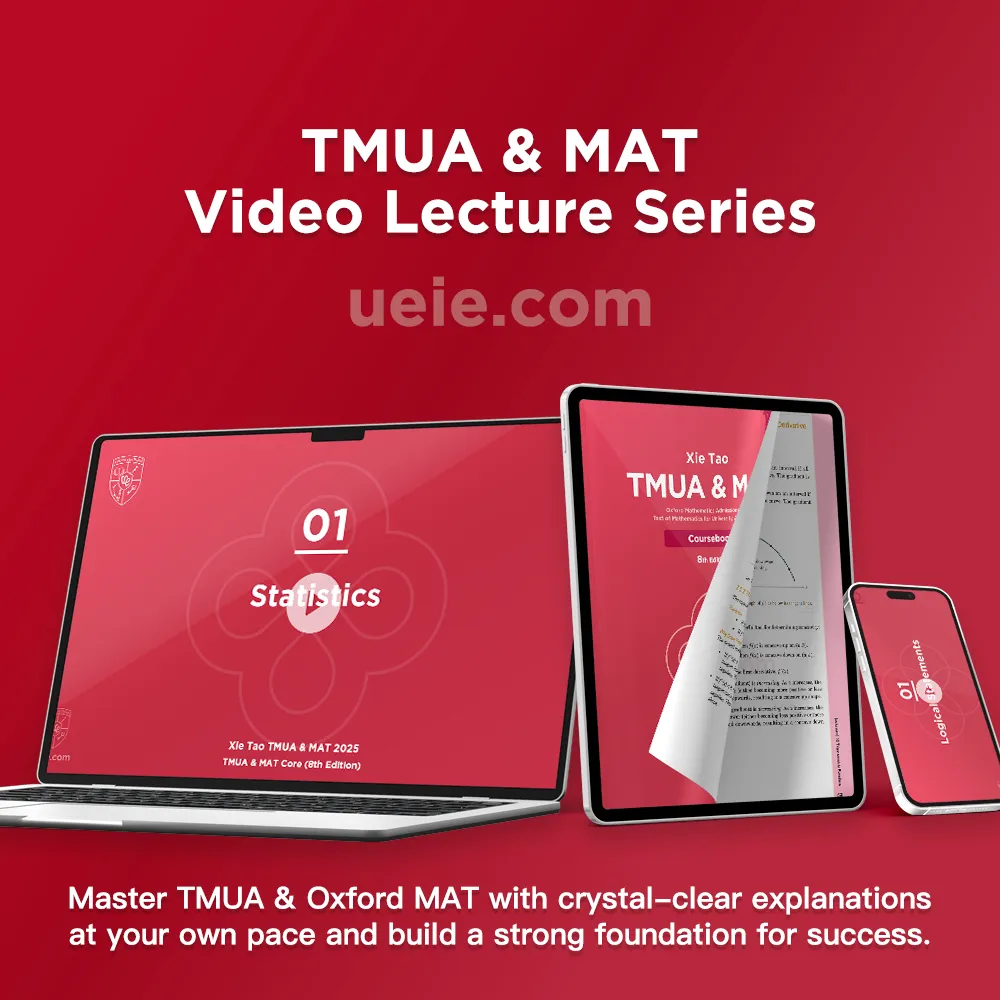
TMUA & MAT Video Lecture Series
Gain a competitive edge with our TMUA & MAT Video Lecture Series. Covering all topics of both exams, these courses offer a comprehensive curriculum, expert instruction from Xie Tao, and the flexibility of on-demand learning.US$709 – US$851Price range: US$709 through US$851
3. Phase 2: Targeted Skill Training and Technique Refinement
Goal
- Focus on the specific types of questions and skills TMUA tests. Improve your speed, use of multiple-choice strategies, and quick mathematical thinking. Make up for the lack of official past papers.
Actions and Resources
- Analysing Official Materials: Use the limited official sample questions and past papers strategically. Analyse every question in detail, focusing on the approach, common traps, and time allocation. Use the official explanations to understand key techniques.
- Targeted Practice: You’ll need good quality extra practice resources. The TMUA Practice Question Bank contains loads of practice questions and is key for this stage, allowing for high-intensity, timed training by question type or topic.
- Refining Techniques: Consciously practise using multiple-choice techniques (elimination, substitution, estimation, etc.), and figure out which methods work best for you.
- Tackling Harder Problems: For challenging problems in official papers or practice sets, use the explanations for difficult problems in the TMUA Video Lecture Series to learn efficient methods and ways of thinking.
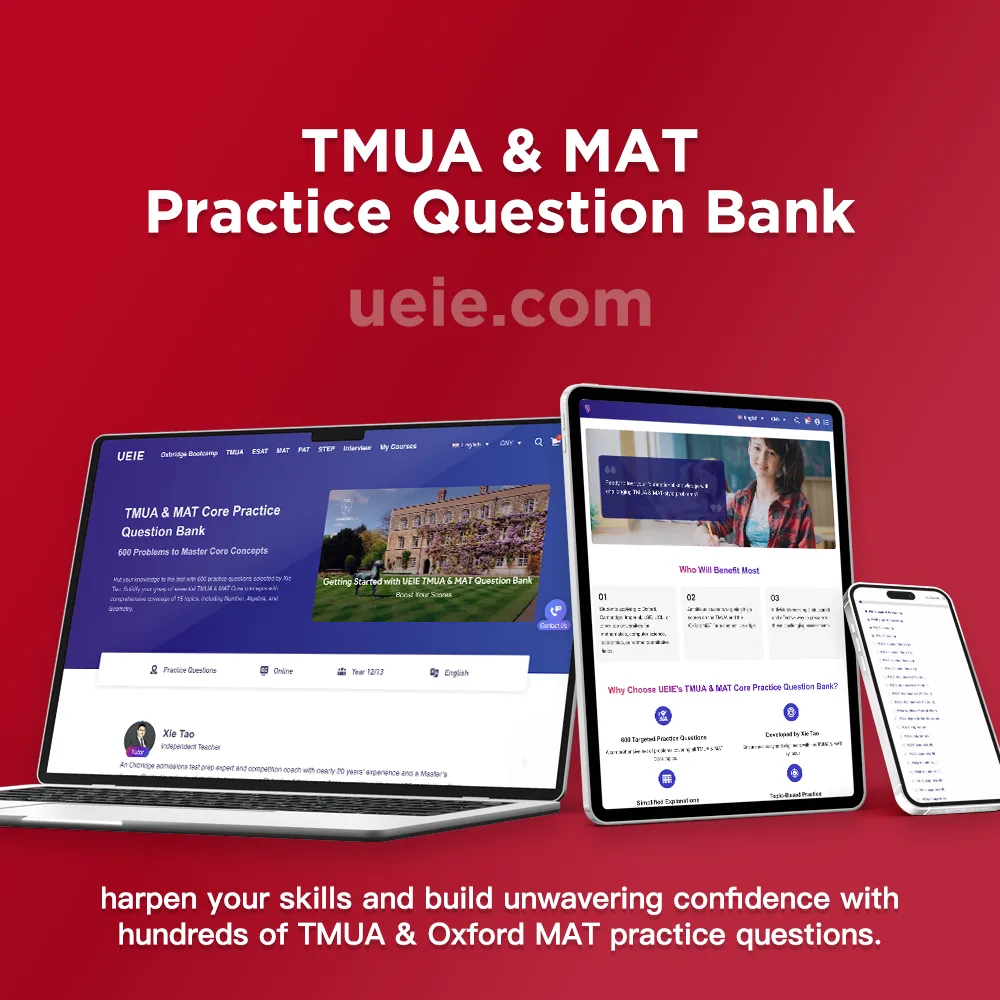
TMUA & MAT Practice Question Bank
Our TMUA & Oxford MAT Practice Question Bank, developed br Xie Tao, offer 1360 problems with detailed solutions, covering all topics of the exams.These questions provide targeted practice for all levels to help you master every topic and achieve your target score.US$666Original price was: US$666.US$555Current price is: US$555.4. Phase 3: Mock Exams and Final Adjustments
Goal
- Fully replicate exam conditions to test your overall level, fine-tune your test-taking strategy, and get into peak condition for the exam.
Actions and Resources
- Sitting Full Mocks: Use the latest official samples, past papers you haven’t done yet, or good quality mock tests (like the UEIE TMUA Full-Length Mock Exams) under strict timing (75+75 minutes) without interruptions. Aim to do at least 3 mocks.
- Testing Your Strategy: Check your approach to choosing questions, managing time, pacing yourself, and using multiple-choice techniques under pressure.
- Addressing Weaknesses & Mindset: Analyse any problems the mocks reveal and do some final targeted practice. Adjust your mindset and build confidence.
5. Advice on Choosing TMUA Preparation Resources
Official Materials:
- The UAT-UK official syllabus, sample questions, and released past papers are essential materials you must work through thoroughly.
Supplementing Official Materials:
- Given the limited official past papers, good quality extra practice resources with plenty of questions (like dedicated practice sets or online platforms) are crucial for TMUA preparation.
Choosing Wisely:
- Use other resources (like MEI, relevant books, online forums) selectively based on your needs; avoid getting overloaded with information and stick to core training.
The UEIE TMUA Test Preparation Solution:
- Designed to tackle the common problems in TMUA prep – like the lack of official papers and the need for lots of targeted practice and effective score-boosting strategies – I developed the UEIE Education TMUA preparation series based on years of experience. This solution includes:
- TMUA Video Lecture Series (with PDF textbook): Systematically explains key syllabus points, tricky areas, and problem-solving strategies.
- TMUA Practice Question Bank (Online): Provides far more practice questions than the official papers offer, categorised by topic and difficulty, filling the gap left by the limited past papers.
- TMUA Full-Length Mock Exams: A total of 8 mock exams, providing a complete learning and testing cycle.
- These materials are updated annually (currently the 2025 8th Edition), keeping them up-to-date with exam trends. They aim to help students improve preparation efficiency and enhance the fluency, speed, and accuracy needed for TMUA, helping you aim for your target score. Click to browse the TMUA Prep Hub—Courses, Practice Set & More Resources.
V. How to Plan TMUA Preparation Time?
‘How long do I need to prepare for TMUA?’ There’s no single answer to this, as it varies from person to person. Unlike STEP’s long cycle and focus on depth, the TMUA preparation cycle is generally shorter but demands extremely high intensity and efficiency in training specific skills.
1. Key Factors
How long you’ll need mainly depends on:
- Target Score Band: Are you aiming for 6.5, 7.0, or even higher? Higher targets usually mean more time spent practising and higher intensity training.
- Starting Proficiency: How solid is your current understanding of AS/GCSE knowledge? How are your calculation speed and accuracy? (Refer back to the self-assessment in Section I).
- Weekly Time Commitment: How many hours of focused study can you realistically commit to each week?
While there isn’t a specific ‘300-400 hour’ guideline like for STEP, reaching the higher TMUA scores still demands plenty of focused, efficient practice.
2. Suggested Timelines Based on Starting Point
Based on typical student profiles, here are some suggested start times and timelines:
- Strong Foundation (e.g., STEP Grade 2+ level, or AIME/BMO 1 competition experience): The main focus is adapting to the multiple-choice format, the speed required, and Paper 2’s logical reasoning style. Starting focused training around 2-3 months before the exam (e.g., starting in July-August for the October exam) is usually about right.
- Average Foundation (e.g., A Level system, no competition or STEP experience): You’ll need to consolidate your knowledge, improve your calculation speed and accuracy, and get used to the TMUA style all at the same time. Starting systematic prep at least 4-6 months before the exam (e.g., starting in May-June for the October exam) is advisable. You’ll need to go through the full cycle of building knowledge fluency, then skill training, and finally mock exam practice.
- AP/IB System Students (no competition or STEP experience): Besides the challenges faced by those with an average foundation, you’ll need extra time to fill any knowledge gaps and particularly work on calculation speed and accuracy, which might be less of a focus in your regular curriculum. It’s highly recommended to start early, ensuring at least 4-6 months or even longer for preparation (e.g., starting in early May or sooner). You’ll need to combine catching up on knowledge with specific TMUA practice.
3. Balancing Prep with Schoolwork
If you’re still at school, balancing things efficiently is key:
- Fixed Schedule: Slot TMUA preparation into your regular weekly timetable.
- Utilise Holidays: Use school holidays for intensive revision and to make big strides.
- Focus on Efficiency: Stay focused during your study sessions and aim for quality over quantity.
- Flexible Adjustment: Adjust the intensity of your TMUA test prep based on how busy you are with schoolwork (like during exam season), but try to keep it going consistently.
- Work-Rest Balance: Make sure you get enough sleep and take proper breaks to avoid burning out and becoming less effective.
VI. Common TMUA Preparation Pitfalls and Countermeasures
In years of TMUA coaching, I’ve seen some common mistakes that really hinder students’ progress and final scores. Spotting and avoiding these can make your hard work count for more.
Starting Too Late / Lack of Planning — Pitfall 1
- What happens: Students underestimate the time needed to reach the required speed and fluency for TMUA. They start too late, meaning they don’t get enough practice later on and struggle to perform consistently under pressure.
- What to do: Plan ahead and be consistent! Use the timeline suggestions in Section V, start early based on your situation, and stick to a regular, high-quality weekly study routine.
Wrong Approach – Knowing vs. Being Fluent — Pitfall 2
- What happens: Thinking that just ‘getting’ a topic is enough, without practising it until it’s extremely fluent, almost automatic; or getting too bogged down in theory and ignoring TMUA’s need for speed and applying the basics; not specifically training multiple-choice strategies.
- What to do: Focus on Fluency and Strategy! The core task is to practise AS/GCSE knowledge until it’s second nature. At the same time, you absolutely must learn and practise specific multiple-choice techniques to find the best balance between speed and accuracy.
Not Enough Realistic Practice — Pitfall 3
- What happens: Doing practice without timing yourself; not doing full mocks under realistic computer-based conditions. This leads to poor time management during the real exam and difficulty adapting to the interface and pressure.
- What to do: Practise Under Exam Conditions! Start early and frequently do practice under strict time limits. If you can, definitely use an online platform for mocks to get used to the interface and timing.
Mindset Issues / Too Much Pressure — Pitfall 4
- What happens: Getting overly anxious about the speed required; losing confidence when faced with hard questions or getting several wrong in a row; being too afraid of the ‘all-or-nothing’ scoring of multiple-choice.
- What to do: Keep Perspective and Stay Calm! Set realistic goals for each stage, and accept that it’s normal not to finish every question or to get some wrong. Practise quickly skipping hard questions and making strategic guesses when needed. Build your resilience.
Ignoring Official Resources — Pitfall 5
- What happens: Not studying the latest official syllabus carefully, leading to gaps in revision; not properly analysing the official samples or the few past papers available, missing chances to understand the question style and what examiners are looking for.
- What to do: Stick to Official Sources and Analyse Them! Go over every official sample and past paper question thoroughly, analysing the concepts tested, potential traps, and solution methods. Keep a close eye on the UAT-UK website for any updates.
VII. Final Words: Mindset and Action
1. Embracing the Challenge: The Right Mindset
Preparing for TMUA is a test of your speed, accuracy, and mental stamina. Success hinges on your mindset: face setbacks head-on and see them as chances to learn; focus on steady progress, be patient, and put in consistent, high-quality effort; keep calm, focus on your own improvement, and maintain a healthy balance between work and rest. Remember, there are no shortcuts – just sensible planning and consistent hard work.
2. Time for Action: Next Steps
Now that you’re clear on the approach, it’s time to act:
- Verify Requirements: Check the latest official admissions policies of your target universities and their specific TMUA requirements.
- Plan and Begin: Using the TMUA Registration Guide and this guide, make a detailed plan and start straight away.
- Utilise Resources Wisely: Make good use of official materials and carefully chosen extra resources (including the UEIE TMUA courses and materials).
Finally, I wish you the very best – may your hard work and ability lead you to succeed in the TMUA and secure a place at your chosen university!
-
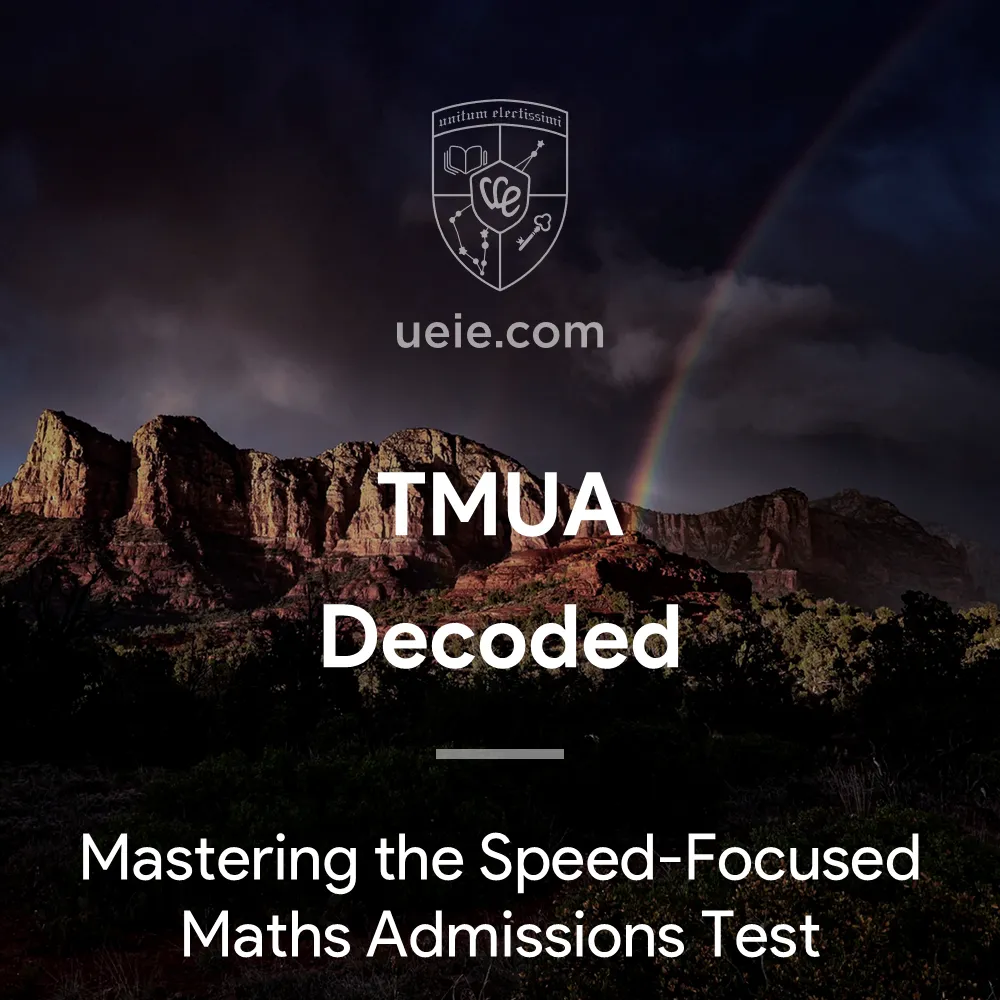
TMUA Decoded: Mastering the Speed-Focused Maths Admissions Test
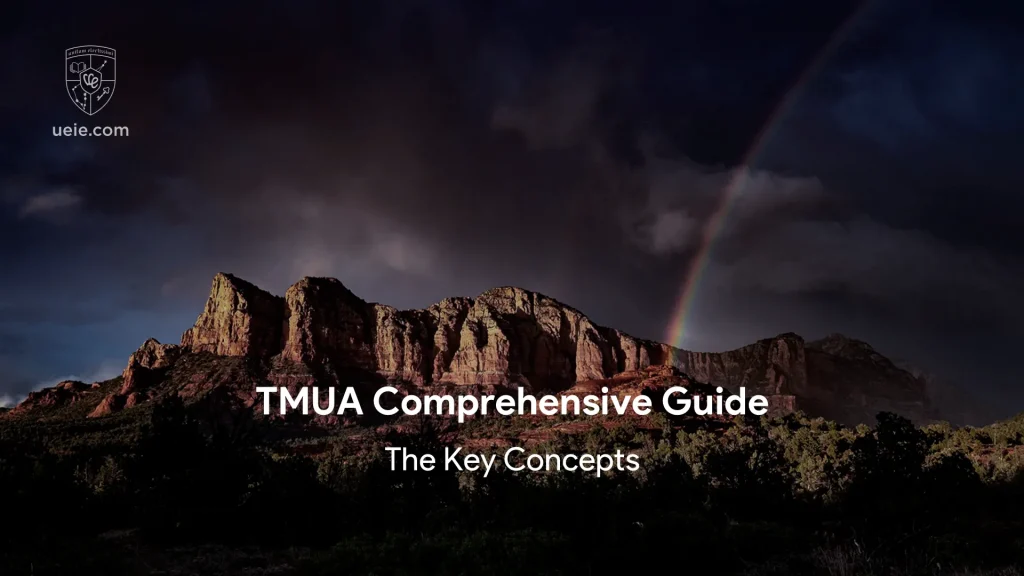
The Test of Mathematics for University Admission (TMUA) is increasingly utilised by leading UK universities as a key means of evaluating applicants’ mathematical aptitude and potential. To help you get fully up to speed with the latest requirements and test details for the 2026 entry application cycle, I’ve drawn on my years of experience coaching for Oxbridge admissions tests to write this TMUA Comprehensive Guide. This guide provides a systematic overview of the latest TMUA developments, university requirements, key dates, test format, scoring criteria, syllabus content, and essential preparation resources, offering you a comprehensive and authoritative reference.
Once you have a general understanding of the TMUA, we recommend reading follow-up UEIE articles: TMUA Registration Guide and TMUA Preparation Guide, for more detailed instructions on registration and preparation strategies.
I. What is the TMUA Mathematics Test?
TMUA stands for the Test of Mathematics for University Admission. Its primary purpose is to assess an applicant’s ability to apply mathematical knowledge to solve problems, as well as their potential for mathematical reasoning. Several top UK universities – including the University of Cambridge, Imperial College London, the London School of Economics and Political Science (LSE), and University College London (UCL) – use the TMUA to help select applicants for undergraduate courses in Mathematics, Computer Science, Economics, and related disciplines.
II. Latest Updates on the 2025 TMUA Test
The TMUA test has undergone significant adjustments in recent years. Keeping abreast of these latest developments is crucial for both preparation and registration.
1. Unified Management Body UAT-UK
Since 2024, TMUA has been managed centrally by UAT-UK, a non-profit organisation jointly established by the University of Cambridge and Imperial College London. It now forms part of their assessment framework alongside the Engineering and Science Admissions Test (ESAT) and the Thinking Assessment for Arts and Humanities (TARA, introduced in 2025).
2. Test Format and Delivery Partner
TMUA is administered as an online, computer-based test. It is delivered by the global assessment provider Pearson VUE through its worldwide network of certified test centres.
3. Specific Date Arrangements and Restrictions
Since 2024, TMUA typically offers testing windows in October and the following January.
- Testing Window Choice: Candidates applying for 2026 entry to relevant courses at the University of Cambridge must take the test in October 2025; the January 2026 session is not an option for them.
- Specific Date Restriction: Candidates applying to the University of Cambridge from Mainland China, Hong Kong, or Macau are not permitted to take the TMUA test on 13 October 2025. Consequently, applicants from these regions targeting relevant Cambridge courses can only sit the TMUA on 14 October 2025.
- Verification is Essential: Please be aware that the specific dates and times available for booking may differ between test centres. Always consult the Pearson VUE registration system and official UAT-UK announcements for the most accurate and up-to-date information.
4. Increasingly Specific University Requirements
As the UAT-UK assessment system has become established, TMUA’s significance as an admissions tool for certain leading universities and specific degree programmes (particularly in Mathematics, Computer Science, and Economics) has grown. Several programmes now mandate or strongly recommend the TMUA (further details are provided in the next section).
III. Who Needs to Take the TMUA Test? (For 2026 Entry)
Specific TMUA requirements vary between UK universities and degree programmes. These requirements can change annually and can be quite detailed (e.g., specifying whether the test is compulsory, recommended, or simply an alternative option). Therefore, all candidates are strongly advised to treat the official websites of their chosen universities as the ultimate authority for the latest admissions information specific to 2026 entry.
1. G5 University Courses Requiring TMUA Scores
The table below lists G5 university courses known to require TMUA scores, provided for reference.
University Courses Approximate Score Reference* Alternative Test / Notes University of Cambridge Computer Science (G400) 7.5+ Usually no alternative Economics (L100) 7.0+ Usually no alternative Imperial College London Mathematics Dept. Programmes (G100, G103, etc.) 6.5+ STEP might be considered in exceptional circumstances, e.g., post-deadline (check website for latest info) Economics, Finance and Data Science (L1N3) 6.5+ London School of Economics (LSE) Economics (L101) 7.0+ Econometrics and Mathematical Economics (L142) 7.0+ Mathematics and Economics (GL11) 7.0+ University College London (UCL) Economics (L100) 6.5+ UCL’s test requirements are complex; check website. Some economics-related programmes may move to TARA *Approximate Score Reference: This is based on unofficial data from previous admission cycles and does not represent a minimum required score.
2. TMUA Requirements at Other Universities
- University of Warwick: Requires applicants for Mathematics, Statistics, Computer Science, and Economics-related courses to submit TMUA scores. However, for Mathematics and Statistics courses, STEP or AEA scores may be accepted as alternatives.
- Durham University, University of Bath, and others: In the past, some Mathematics, Economics, and Computer Science related courses at these and other universities have also required TMUA scores.
Requirements regarding the TMUA test for specific courses at different universities can change. Once you have decided which universities and courses you are applying to, it is recommended that you consult the official university websites to understand the latest and most accurate entry requirements.
IV. TMUA Test Key Dates
Below is a summary of the key dates for the Autumn 2025 and Early 2026 testing sessions. Please note that the registration periods shown are provisional; you should closely monitor official announcements for confirmed dates.
1. Autumn 2025 (1st Sitting) Schedule
Key Stage Date Registration Period 31 Jul – 29 Sep 2025 Test Dates 13–14 October 2025 Results Release 14 Nov 2025* Key Restrictions:
- Candidates applying for Economics and Computer Science at the University of Cambridge must take the test during this session.
- Candidates applying to the University of Cambridge from Mainland China, Hong Kong, or Macau are not permitted to sit the test on 13 October 2025 and must therefore take it on 14 October 2025.
2. Early 2026 (2nd Sitting) Schedule
Key Stage Date Registration Period 27 Oct – 19 Dec 2025 Test Dates 8–9 January 2026 Results Release Approx. 6 weeks after test* Key Restrictions:
- This session is not available for candidates applying to the University of Cambridge.
*UAT-UK will notify candidates by email when their results are available to view in their UAT-UK account. Candidates will also receive a document explaining how to interpret their results.
V. TMUA Test Format and Structure
The table below summarises the key elements of the TMUA test format.
Item Details Format Online Computer-based Test, taken at a Pearson VUE test centre. Paper Structure Two Papers: - Paper 1: Applications of Mathematical Knowledge
- Paper 2: Mathematical Reasoning
Question Type Multiple Choice Questions Number of Questions 20 questions per paper, total 40 multiple-choice questions. Duration 75 minutes per paper, total 150 minutes. Timing Each paper is timed separately. Time unused in Paper 1 cannot be carried over to Paper 2. Calculator Calculators are not permitted. Formula Sheet Formula sheets are not permitted. VI. TMUA Scoring Mechanism and Result Interpretation
1. Scoring Mechanism and Score Conversion
- Raw Score: Each multiple-choice question is worth 1 mark. Incorrect answers or unanswered questions score 0 marks. The maximum raw score for each paper is 20, making the total maximum raw score for the test 40.
- Score Conversion: To ensure comparability of results across different test sittings, raw scores are converted to a standardised scale ranging from 1.0 to 9.0, usually reported to one decimal place. Universities primarily use this 9.0-scale standardised score for assessment purposes.
- Important Change in Results Report: From 2024 onwards, the official TMUA results report provided by UAT-UK only includes the overall converted score, no longer providing separate converted scores for Paper 1 and Paper 2. A more detailed official explanation of the results report can be downloaded from the UAT-UK website.
2. Result Interpretation: Competitiveness Analysis by Score Band
There is no official Pass Mark for TMUA. Whether a score is competitive depends entirely on the university and course you are applying to, as well as the overall standard of applicants in that year. Based on the official UAT-UK explanation of the 2024/25 TMUA results and my own experience with students, here is an interpretation of some representative scores:
- 4.5 is the average score: This suggests that most students achieve scores around 4.5. From observing numerous students, the majority who attain an A* in A-Level Mathematics can reach this level without systematic preparation. A score of 4.5 can be broadly considered equivalent to an A* standard in A-Level Maths.
- Around 7.0 places you in the top 10%: Based on application cases from students I coached last year, those achieving this score typically received interview invitations from Cambridge and had a high success rate in securing offers from other G5 universities like Imperial and LSE.
- Only about 5% of candidates score 8.0 or above: Candidates scoring in the 8.0-9.0 range are undoubtedly highly competitive. Although Cambridge’s final decision also considers interview performance and other application materials, such scores significantly increase the chances of receiving offers from top institutions like Imperial, LSE, and UCL.
VII. TMUA Syllabus and Difficulty Analysis
Understanding what TMUA assesses and where its difficulties lie is fundamental to devising an effective preparation plan.
1. Syllabus Overview for TMUA Test
Although the organising body for TMUA test changed in 2024, the overall syllabus has seen little change, especially for Paper 2, where the syllabus remained untouched.
Paper 1: Applications of Mathematical Knowledge
- Assessment Objective: To assess the candidate’s ability to apply mathematical knowledge flexibly to solve problems.
- Knowledge Scope: Primarily based on AS Level Mathematics content, including Algebra and Functions, Coordinate Geometry, Sequences and Series, Trigonometry, Exponentials and Logarithms, Calculus, and Graphing Functions. It also covers some GCSE Mathematics content, such as Number and Units, Ratio and Proportion, Basic Algebra, Geometry, Statistics, and Probability.
Paper 2: Mathematical Reasoning
- Assessment Objective: To assess the candidate’s ability in mathematical reasoning and logical thinking.
- Knowledge Scope: Builds upon the mathematical knowledge required for Paper 1.
- Emphasis: Focuses on understanding the logic of arguments, mathematical proof (including identifying common errors in proofs), and higher-level logical reasoning problems.
Accessing the Official Latest Syllabus
Please ensure you consult the latest version of the TMUA syllabus document published on the UAT-UK official website.
2. Difficulty Characteristics Analysis
The difficulty of TMUA differs from tests like STEP. It doesn’t lie in the intrinsic complexity or abstruseness of the problems, but rather in the following aspects:
- Extreme Time Pressure: The average time of 3.75 minutes per multiple-choice question is the core challenge of TMUA test. This demands not only solid knowledge but also exceptional problem-solving efficiency and speed.
- Breadth of Knowledge and Fluency: The test covers a wide range, requiring candidates to be extremely fluent with fundamental concepts, able to recall and apply them quickly and accurately. The prohibition of calculators places higher demands on mental arithmetic and written calculation skills.
- Mathematical Reasoning Requirements: The logical thinking, proof comprehension, and error identification skills tested in Paper 2 require dedicated training to adapt and improve accuracy.
- Multiple-Choice Format: Although multiple-choice, the questions and options are often cleverly designed, incorporating traps and distractors, necessitating careful reading, precise calculation, and effective elimination. There are no marks for working, yet the demand for accuracy is extremely high.
In short, TMUA primarily assesses a student’s fluent application of mathematical knowledge and the agility and accuracy of their mathematical reasoning under strict time constraints. Its difficulty stems more from the demands for ‘speed’ and ‘accuracy’ rather than ‘depth’ and ‘complexity’.
VIII. How to Register for the TMUA Test?
Since 2024, the registration process for the TMUA test has changed compared to the past, primarily conducted through the officially designated online platform.
1. Main Pathway
Candidates need to register via the website of Pearson VUE, the official partner testing service for UAT-UK. This usually involves first creating a UAT-UK personal account and then using that account to book a test session and location.
2. Key Reminders
- Registration Deadline: Pay close attention to the official registration deadline for the test session you plan to take (refer to Section IV of this article, and confirm with the final official announcement). Complete registration and payment in advance.
- Limited Test Slots: Test slots in popular locations may be limited. It is advisable to register and book your test as early as possible once registration opens.
3. Registration Process
Detailed information regarding the steps for account creation, required information, test centre search and selection, test fees, payment methods, and applications for special arrangements (if needed) are all explained step-by-step in our dedicated guide.
Please click the following post for the most complete and accurate operational instructions.
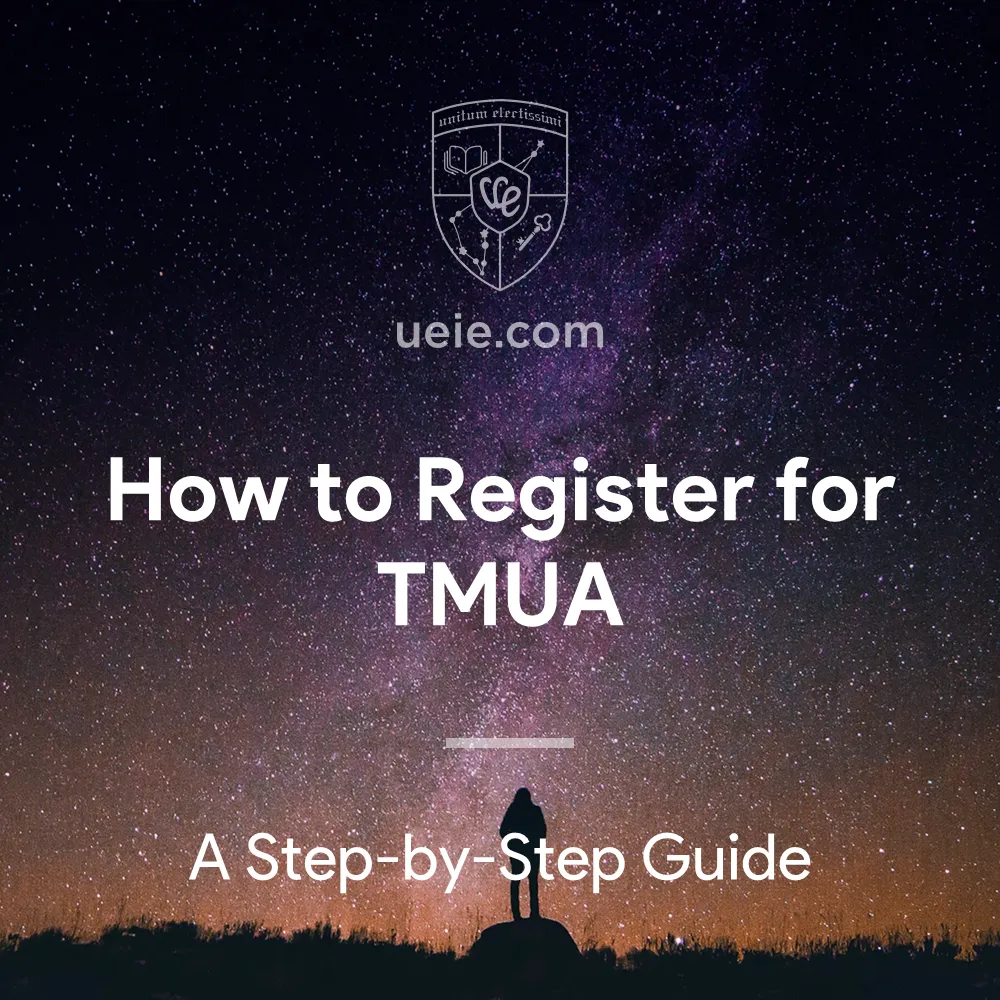
How to Register for TMUA
Unlock your TMUA potential with our comprehensive guide! Follow our 4-step plan to register for TMUA and boost your application.IX. TMUA Test Core Preparation Strategy and Resource Recommendations
Having grasped the fundamental information about TMUA, how should one approach preparation? I will first outline the core preparation strategy, then recommend relevant resources.
1. Core Preparation Strategy for the TMUA Test
Given that TMUA primarily assesses the fluent application of mathematical knowledge, agility and accuracy in mathematical reasoning, under strict time limits (see Section VII), the preparation strategy should focus on:
- Knowledge Level: You must achieve high fluency in the required AS Mathematics and relevant GCSE content outlined in the syllabus, ensuring concepts can be recalled instantly and applied rapidly.
- Skills Level: Focus on training and improving calculation speed and precision (in a non-calculator environment), agility in logical judgement, and strategies and techniques for tackling multiple-choice questions (especially identifying distractors).
- Practice Level: Extensive, targeted timed practice is essential to adapt to the exam pace and translate knowledge and skills into stable performance under pressure.
The above represent the core directions for TMUA preparation. For detailed strategies and steps on systematically planning preparation, implementing phased learning, using specific training methods (like error analysis, time management techniques), and enhancing specific abilities, please be sure to read my dedicated post TMUA Preparation Guide.
TMUA Preparation Guide:

Conquer the TMUA: Speed & Accuracy Training for Top Maths Scores
Aiming for a high score in the speed-focused TMUA test? This guide provides core strategies for effective preparation, focusing on enhancing calculation speed & accuracy (no calculator), developing logical agility, mastering MCQ techniques, and resource planning.2. Official Core Resources
You can obtain the most authoritative information from the UAT-UK official website, including:
- The latest version of the TMUA syllabus
- Official specimen papers and practice materials
- Examination guidance and FAQs
- Past papers (2016-2024)
3. UEIE TMUA Courses and Materials
To enhance the efficiency and effectiveness of TMUA preparation, I (Mr. Xie Tao) have developed a comprehensive set of TMUA preparation materials based on years of admissions test teaching experience. This set includes detailed video lectures, accompanying PDF textbooks, online practice question banks, and full-length mock exams. I revise and update these materials annually to ensure they align with the latest exam trends and requirements.
TMUA & MAT On-Demand Prep Suite

TMUA & MAT On-Demand Prep Suite
The TMUA & MAT On-Demand Prep Suite is your all-in-one solution for exam success. This comprehensive package combines Xie Tao’s expert video lectures, a massive bank of 1360 practice questions with detailed solutions, and 12 full-length mock exams that mirror the real test. Prepare thoroughly, build confidence, and achieve your target score.US$1 278 – US$1 847Price range: US$1 278 through US$1 847
Additionally, I collaborate with several international schools to offer TMUA preparation classes. Interested students and parents can find details about related courses and materials via the following link.
TMUA & MAT Live Classes

TMUA & MAT Preparation Programme
Prep for both and save time. This all-in-one programme provides 130 periods, 9 unseen TMUA mocks, 3 predictive papers, and 6 MAT mocks, helping you systematically master both exams. Click to view the bundle.US$3 102 – US$12 777Price range: US$3 102 through US$12 777
4. Other Supplementary Resources
- Relevant Mathematics Resource Websites: Websites like MEI (Mathematics Education Innovation) offer practice questions and resources related to AS/GCSE Mathematics.
- Problem-Solving Books: Some books focus on enhancing mathematical thinking, problem-solving speed, and accuracy.
- Online Communities and Forums: Platforms like The Student Room (TSR) may offer shared experiences, but please evaluate information critically.
5. Resource Usage Suggestions
- Prioritise Official Materials: Use the UAT-UK official syllabus and specimen/past papers as the core.
- Be Targeted: Select supplementary resources based on your preparation stage and weak areas.
- Select Efficiently: Quality over quantity; avoid information overload.
- Engage Actively: Actively think, deeply review, and summarise when using any resource.
X. Next Steps Recommended
After reading this Comprehensive Guide to TMUA, you should have a clear grasp of the key information regarding this test. To translate this understanding into effective application preparation, we recommend you take the following actions immediately:
1. Verify Official Requirements
Immediately visit the official admissions websites of your target universities and courses. Carefully confirm their latest and most accurate entry requirements for 2026 entry, especially regarding specific regulations for TMUA (or other admissions tests), score references, and alternative options.
2. Plan Exam Registration
Read the TMUA Registration Guide in detail to fully understand the registration process, required materials, deadlines, and test centre selection. Remember the registration deadlines and ensure you complete registration and booking within the specified timeframe.
3. Develop a Preparation Plan
Study the TMUA Preparation Guide thoroughly. Combining the difficulty analysis from Section VII and the preparation strategy from Section IX of this article, create a detailed and feasible preparation plan tailored to your situation. Start preparation early, especially for those needing significant improvement in speed and fluency.
4. Select Preparation Resources Carefully
Download and study the latest TMUA syllabus and official specimen/past papers from the UAT-UK website. Based on your preparation plan, selectively use high-quality supplementary resources, such as the preparation courses and materials offered on the UEIE TMUA preparation page, for systematic learning and targeted training.

TMUA Prep Hub
Master the TMUA with UEIE’s Prep Hub! We offer everything you need to succeed: in-depth video lecture series, extensive practice question bank, realistic full-length mock exams, expert guides, and insightful data analysis.Finally, thorough preparation and a positive attitude are key to tackling the TMUA challenge. Wishing you success in your preparation and application, ultimately securing an offer from your desired university!
-

How to Register for TMUA
For students aspiring to read mathematics, computer science, or economics-related degrees at leading UK universities, such as the University of Cambridge and Imperial College London, the Test of Mathematics for University Admission (TMUA) is a vital part of the application process. The TMUA result is a significant factor influencing offers of admission. However, many students and their parents are unacquainted with the particulars of TMUA registration, including the procedures, timelines, and appropriate test session. This article offers a thorough guide to the TMUA registration process, aiming to clarify common uncertainties.
I. TMUA Organisation and Administration
Since 2024, the TMUA has been centrally managed by UAT-UK (University Admissions Tests – UK), a not-for-profit organisation. UAT-UK focuses on university entrance examinations in the United Kingdom and currently oversees two computer-based testing programmes: ESAT and TMUA. Pearson VUE delivers these tests. It is the certification and licensure arm of Pearson, an internationally recognized learning company. With a vast network of over 5,500 test centres across more than 180 countries and territories, Pearson VUE provides professional assessment services to academic and admissions bodies globally.
II. Key Dates for the 2025 TMUA Test
The TMUA has two test sittings, scheduled for October 2025 and January 2026. The pertinent dates are outlined below:
1. October 2025 TMUA Test
31 July 2025 TMUA Registration Opens 29 September 2025 TMUA Registration Closes 13 & 14 October 2025 TMUA Test Dates 14 November 2025 TMUA Results Released 2. January 2026 TMUA Test
27 October 2025 TMUA Registration Opens 19 December 2025 TMUA Registration Closes 8 & 9 January 2026 TMUA Test Dates To Be Confirmed (anticipated within six weeks of the test) TMUA Results Released Important Notes Regarding Test Window Selection:
Applicants to the University of Cambridge must register for and sit the October examination. The January examination is not available to Cambridge applicants.
Specific Date Restriction for Certain Localities:
The University of Cambridge does not permit candidates from mainland China, Hong Kong, and Macau to sit the TMUA examination on 13 October 2025. Therefore, applicants from these localities targeting Cambridge must sit the TMUA examination on 14 October 2025.
III. TMUA Registration Procedure
1. Create a UAT-UK Account
- Candidates must create a UAT-UK account on the official Pearson VUE website. (It is prudent to consult the official UAT-UK website for the latest registration guidance).
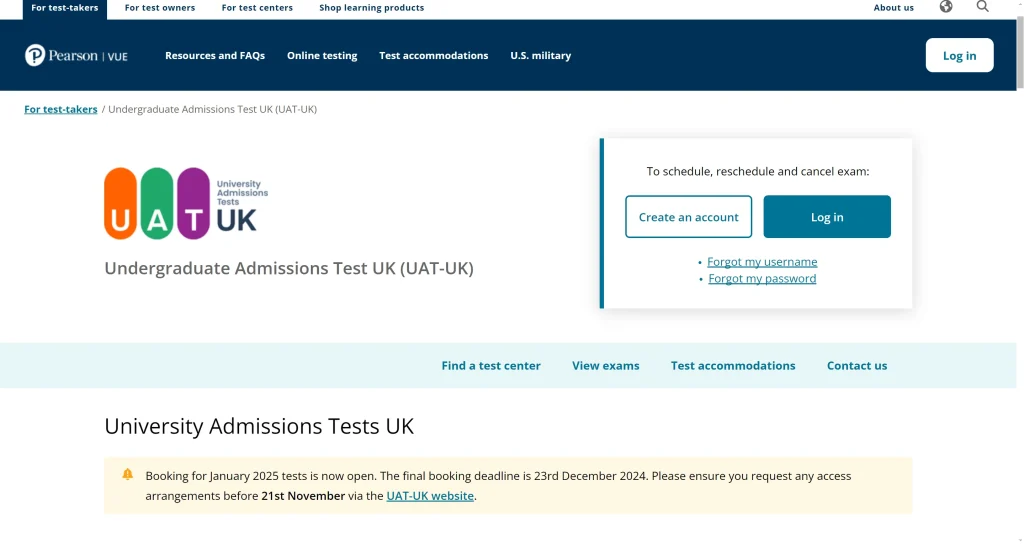
- It is imperative that the name used for UAT-UK account registration precisely matches the name on the candidate’s identification document. Discrepancies may prevent the candidate from sitting the examination. Candidates should also ensure their name matches their UCAS application name.
After creating an account, Pearson VUE will email candidates. This email enables them to confirm details and account settings. Candidates should receive it within 24 hours. This email will also include a temporary password for the candidate’s account.
- Upon receipt of the account confirmation email, candidates may log in using the temporary password, subsequently change their password, and locate their UAT-UK ID (format: UATUK######) in the top left-hand corner of the page navigation bar.
2. Examination Booking
- Log in to your UAT-UK account on the official Pearson VUE website and select the option to book the TMUA examination.
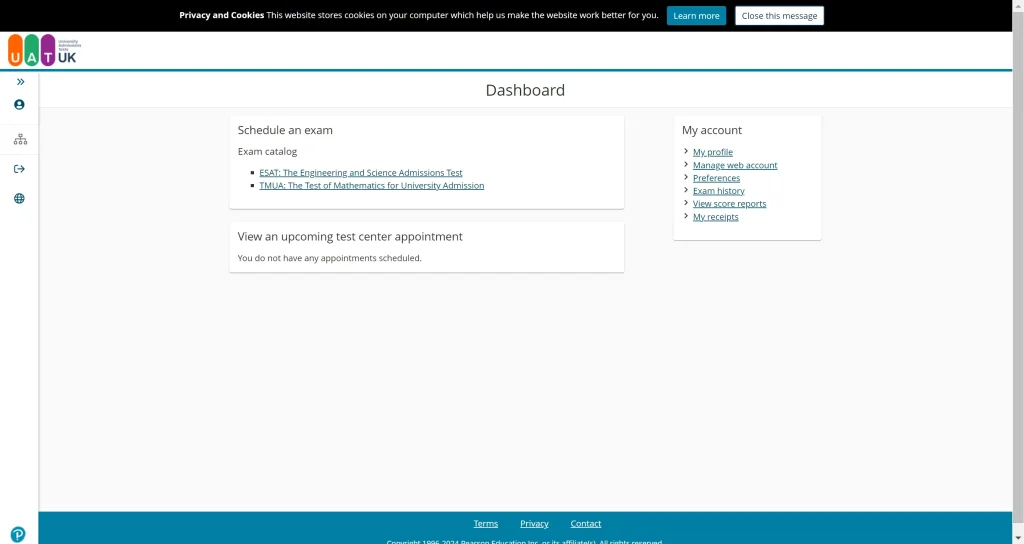
- Provide personal information pertinent to the examination. The system denotes compulsory fields with an asterisk (*).
- Candidates can locate their nearest test centre via the Pearson VUE website to complete their TMUA registration. Please note that sought-after test centres have limited places, especially as the registration deadline approaches. We strongly advise booking well in advance.
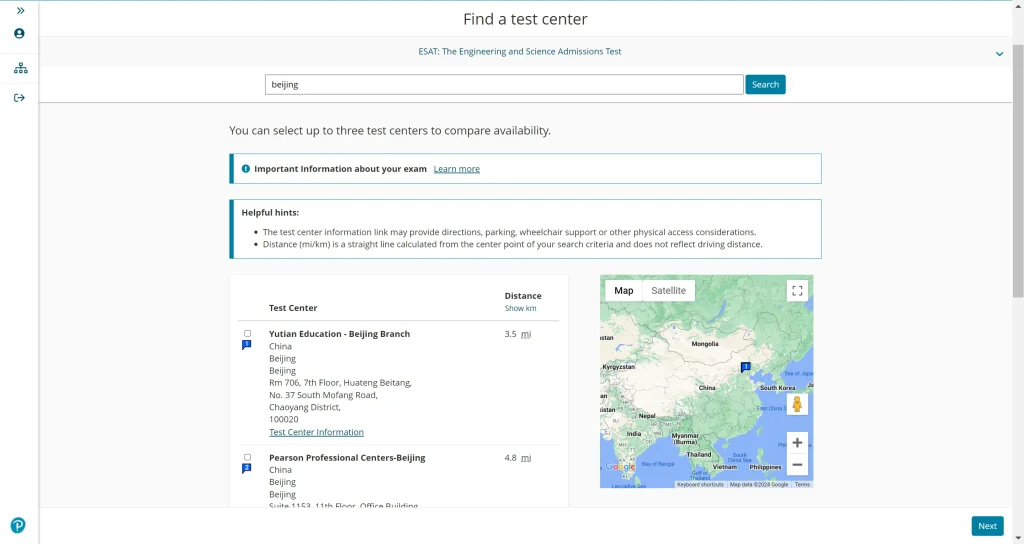
3. Post-Registration and Pre-Examination Steps
- Retain Confirmation Letter: It is strongly recommended that candidates save or print the examination confirmation letter issued by Pearson VUE once registration and payment are complete. This document usually serves as proof of entry for the examination.
- Familiarise Yourself with Test Centre Regulations: Candidates are advised to visit the Pearson VUE website or contact their test centre before the examination to apprise themselves of specific test centre rules and regulations.
- Official Contact Details: For any queries, candidates may contact the Pearson VUE candidate services helpline on 866 892 4788 (toll-free) or liaise with official customer service through the customer service centre on the Pearson VUE website.
4. Examination Fees
- For candidates sitting the TMUA examination outside the UK and the Republic of Ireland (including mainland China), the fee is generally £130.
- For candidates sitting the examination within the UK and the Republic of Ireland, the fee is £75.
IV. Access Arrangements
Candidates requiring access arrangements are advised to register for the examination at the earliest opportunity. Registering later may diminish the likelihood of securing arrangements at the preferred date and test centre. UAT-UK may take up to ten working days to process applications for access arrangements. Furthermore, the deadline for applying for access arrangements is typically in advance of the standard registration deadline. It is essential to check and submit such applications with ample time.
All applications for access arrangements must be substantiated by evidence from a medical practitioner or specialist teacher, clearly detailing the candidate’s disability, medical condition, or other relevant circumstances.
Types of access arrangements that necessitate application and approval include:
- 25% extra time
- Supervised rest breaks
- Separate invigilation (rooming)
- Use of a coloured reading overlay or bookmark
- A reader or scribe
- Other (please supply specific details of any aids or modifications required)
V. Cancelling TMUA Registration
- Candidates may cancel or amend their examination booking up to 48 hours prior to the scheduled test without penalty.
- Cancellations or amendments must be effected by logging into the Pearson VUE website account or by contacting customer services for assistance.
- Should a candidate fail to cancel or amend their booking in good time, or fail to attend the examination, the examination fee will be forfeit.
- It is important to appreciate that the TMUA examination is conducted over only two days. The feasibility of successfully rescheduling an examination date is dependent upon availability at the selected test centre.
- The precise cancellation and amendment policy will be as per the terms and conditions stipulated by Pearson VUE at the point of booking.
VI. Concluding Thoughts
In the competitive arena of applications for mathematics, computer science, and economics-related courses at Cambridge and other UK universities, a thorough grasp not only of TMUA test content and preparatory techniques but also of the nuances of the registration procedure is essential for a trouble-free application process.
You may also find it beneficial to peruse our related articles, which offer a comprehensive analysis of the TMUA examination and a study guide designed to augment your preparation and effectively enhance your TMUA score. Please click the link below.

TMUA Decoded: Mastering the Speed-Focused Maths Admissions Test
Applying for Maths, CS, or Econ at Cambridge, Imperial, LSE? Understand the TMUA test (Test of Mathematics for University Admission), managed by UAT-UK. This guide covers the online format, syllabus, 9-point scoring, key dates, and speed/accuracy focus.
Conquer the TMUA: Speed & Accuracy Training for Top Maths Scores
Aiming for a high score in the speed-focused TMUA test? This guide provides core strategies for effective preparation, focusing on enhancing calculation speed & accuracy (no calculator), developing logical agility, mastering MCQ techniques, and resource planning. - Candidates must create a UAT-UK account on the official Pearson VUE website. (It is prudent to consult the official UAT-UK website for the latest registration guidance).